#where the story of the original series up to arc 4 has just warped so much it's basically a different story
Text
brand new warrior cats headcanon time. if dead cats fade when the living forget them i think it would be cool if they changed appearances based on the clans' general cognition of them. like for example thunderstar. thunderstar during life is still a pretty huge cat but then he dies and slowly he appears larger, maybe more intimidating or more noble - depending on who's looking at him of course - until at some point it seems to the living he's the most impossibly giant cat to have ever lived (until they meet the sisters but that's a different story).
you could do this with dark forest cats also. tigerstar dies and sure there are still cats who knew him while he was living, but he starts to attain nursery-myth legend and his ghost begins to distort. his stripes are that much more distinct, his teeth and claws seem to get bigger and sharper, the wound on his stomach opens up wider and wider, etc etc. the potential for character design is huge.
#partially inspired by the retelling myths in The Road to Immortality (one of if not The best wc fangame of all time btw. required reading.)#where the story of the original series up to arc 4 has just warped so much it's basically a different story#if you wanted to go above and beyond you could also have it be that the precise details vary depending on who is observing the spirit#i have the image in my mind of firepaw somehow seeing thunderstar (dream sequence? moonstone?) and thunder is like towering over him#kinda intimidatingly. not outwardly mean but firepaw is like Dude you're nice but you're kinda freaking me out#but then later on as fireheart/star comes to feel more Part of thunderclan and idk learns more about thunder himself thunderstar reappears#and he's firestar sized although maybe not firestar shaped. this sounded and looked a lot better in my head oh well#warrior cats#low pitched finite woofing
7 notes
·
View notes
Text
Enterprise is also Leaving Netflix. What Should you Watch Before it Boldly Goes Away
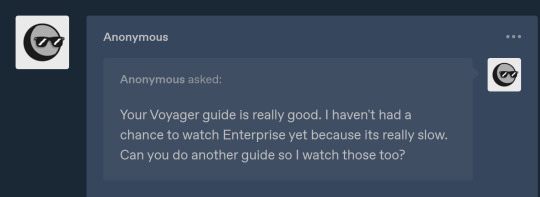
So let’s talk about Enterprise shall we? The black sheep of Trek, it is very different from what came before it. And you are right, Enterprise starts off slow. R e a l l y s l o w. Do not let that stop you, Enterprise has a lot to offer! How you can watch depends on how much you have to put into the show:
Option 1 - Long Option

Enterprise is primarily comprised of story arcs in its third and fourth seasons. You can see Star Trek actively starting to transition its’ form of storytelling from usually one- or two-episode stories to the multi-episode to season-long story arcs we typically see in TV today. I will also not be the first to say that Enterprise really blossoms in those two seasons. Because of this, it is really hard to just jump into an episode in the middle of a story arc without being a little lost
Your best option is to watch all of the Xindi story arc and most of the story arcs in season 4.
Start at season 2 episode 26 The Expanse and watch all the way to season 4 episode 21 Terra Prime. This is the true series finally, do not watch These are the Voyages, it is one of the most insulting series finales, like worse than Seinfeld.
Please note that you can skip season 4 episodes 18 and 19 if you don’t like/ are annoyed by the Mirror Universe. These are for-fun episodes that I enjoyed, but I understand are not for everyone. Additionally, season 4 episodes 10 and 11 are not part of any broader story arc, but I would only skip episode 11, Observer Effect. I personally really like episode 10, Daedalus, which gives insight into the history of the Star Trek Universe.
This leaves you with anywhere from 42-46 episodes to watch. Now if that seems like a lot, don’t worry! You can always watch:
Option 2 - Just 10 Episodes
Season 1 Episode 13 - Dear Doctor

Ship's Doctor and resident non-human character Phlox is on Enterprise in a type of exchange program, with a human taking his place on a Denobulan vessel as they strive to learn more about each other's cultures. Phlox writes his human counterpart a 'Data's Day' style letter in which he recounts the adventure of the day. So what's on the menu today? Oh, I don't know, just the origination point of the Prime Directive, you might have heard of that before.
Season 2 Episode 23 - Regeneration

Regeneration is a follow-up to the movie, Star Trek First Contact. Yes. I am serious. A group of scientists encounters a crash site where they find Borg corpsickles and so kindly bring them back. This means that the Borg's attack at Wolf 359 was actually a predestination paradox created by the same man who leads the charge against the Borg at that very battle. Yikes. Overall though, a Borg episode was surprisingly appreciated, reminding us that this is overall still a part of the current Star Trek canon.
Season 2 Episode 24 - First Flight

The point of Enterprise was to give us a glimpse into the early years of human space exploration. While we only saw so much, we did see the beginning of humans traveling at faster than warp speeds. As part of the NX program that spawned Enterprise herself, many tests had to be made to push the maximum possible speed. Of course, being the prolific piolet he was, Archer was there. Making drama.
Season 3 Episode 8 - Twilight

Enterprise ran into an anomaly that slams into a corridor where Archer and T'Pol are. T'Pol becomes trapped and Archer frees her. This allowed her to escape, but he did not share her fate, being rendered unconscious by the same anomaly. That was 12 years ago. As a result of his injury, he can no long-term memories and Archer has to come to grips with what has been lost during that time. This is my favorite episode of Enterprise, that invokes shades of DS9's The Visitor and Voyager's Year of Hell. In my research, I found out that this was originally pitched as a Voyager story which is now so obvious. The relationship between Archer and T'Pol is never romantic, but you can see the true care they have for each other in their interactions here.
The “Romulan Interference” Arc
Season 4 Episode 12 - Babel One
Season 4 Episode 13 - United
Season 4 Episode 14 - The Aenar
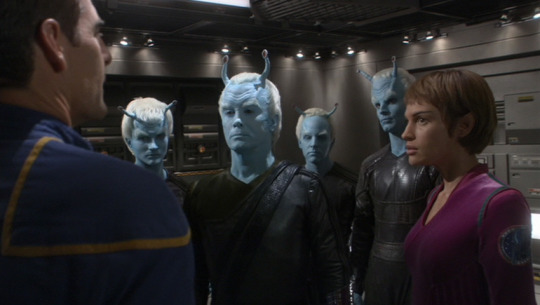
I have decided to select this three-episode arc which is defined by Memory Alpha as the Romulan Interference Arc. By trying to turn the founding members of the federation against each other, the Romulans accidentally created one of their biggest rivals. Oops. Of course, the Romulans are not the main focus, where this really shines is the interplay between the different cultures of the founding races, the humans, Vulcans, Andorians, and Tellarites. You can see that this was originally planned to be long and drawn out, but they did a good job of condensing it into a nice little arc. Andorians are at their best in Enterprise and this is the most in-depth look that we see in the series. Star Trek Legend Jeffery Combs plays Shran and of course he is amazing, his chemistry with Archer is real. As a reoccurring character, this is not the first or last time we see Shran, but probably the most focused look we have on the character.
The “Xenophobic Humans” Arc
Season 4 Episode 3 - Home
Season 4 Episode 20 - Demons
Season 4 Episode 21 - Terra Prime
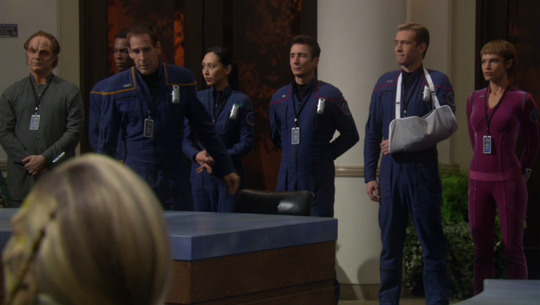
Another arc here to round off the list. I had originally only planned on placing episodes 20 and 21 here, but as there is setup done earlier in the season, episode 3, so I have also included it here as it contributes to a bigger part of the story. It makes sense after all that people have been through after the Xindi war, there would be pro-isolation groups. Heck, they probably were already there, but it makes sense that here, the tension would grow. It’s kind of ironic that after all of these struggles with alien races, the climax of the series sees a struggle not among aliens, but among humans. As a premise, this is what we all expected of Enterprise, a Coalition among explorers coming together to see what is beyond their shores. This is the true ending of Enterprise.
Again there are multiple ways to watch Enterprise, and again, these are just snippets. I know I left out some episodes that people will probably enjoy like The Expanse, Carbon Creek, or even the pilot Broken Bow (which in my opinion is the best pilot episode in the pre-reboot Star Trek era). This list was composed of episodes that would best give the Enterprise flavor, and in my opinion, the effect of an episode on Star Trek mythology was one of the biggest contributing factors. Would love to know what you think or if there are other episodes that should be added.
114 notes
·
View notes
Text
LGBTQ Manga Review - Fragtime (Complete Series)

I recall reading the first few chapters of Fragtime on Manga Cross and not being very impressed. I did not care for it much, as, other than the time stopping element, it was mostly generic and had a few too many unsavory elements. I was content to let it rest and be forgotten along with a hundred other girl-meets-girl school Yuri romances until Tear Studio and the people behind the excellent Kase-san and Morning Glories OVA announced an anime adaptation of the work, a full five years after it ended. Inevitably an English adaptation of Sato’s original manga was announced, and so here I am, somewhat reluctantly reading and reviewing the two-volume series. It may sound like I am pessimistic or already had my mind made up, but that is not true. I went into Fragtime with as open a mind as possible, and I am happy to say that I did find several favorable aspects that appealed to me. Sadly, the manga mostly lived up to my poor initial impressions from all those years ago.
Fragtime follows timid high school student Moritani Misuzu, who can stop time for three minutes a day. While using her power, she attempts to look up the skirt of one of her classmates, Haruka Murakami. To her horror, Moritani discovered that Haruka is the one person immune to her ability. The two form an unlikely friendship and spend those few minutes when all others freeze together. As Moritani’s feelings for Haruka grow, her powers begin to fade, throwing their time together in jeopardy.

At first, this story appears to have some promise, along with some obvious issues. The supernatural aspect of Moritani’s powers and its connection to her emotions and relationship with Haruka provide excellent possibilities and avenues to explore the series’ romance and characters. Sadly, Sato delivers an unwieldy story with unlikeable and inconsistent subjects, a poorly paced narrative, and far too many sleazy moments to excuse. This last point is the most prominent of all and will be a turn off for many readers, myself very much included.
Moritani begins the story by “upskirting” one of her classmates. It is later revealed that she reveled in exploring the time-frozen school to pry into people’s most intimate moments, many of which frankly do not happen in schools nearly as much as the story would like to believe. Following this event are multiple scenes with characters flashing each other their panties, or else stripping to whatever the opposite of readers’ delight is. These moments are not sexy, and while a few of them appear to have been attempts at comedy, they will elicit few laughs. These factors create an overwhelming blanket of immature perversion that stifles any enjoyment in the audience and characters.
Another egregious element is a plotline where Haruka is continually sexually abused by her teacher, something used by her to manipulate Moritani, then joked about, and never resolved despite being referenced a good half-dozen times throughout the manga. More than anything, this speaks to Fragtime’s inability to treat its characters with any respect or focus on a plot arc and complete it satisfactorily. For indeed, even if one undergoes the arduous task of shrugging off the uncomfortable fanservice, there is not much noteworthy content left underneath.

Fragtime’s highschool Yuri romance plot is pretty unextraordinary. Even though it did attempt to include a few interesting plot points, like when Haruka and Moritani begin dating partway through the series, it is not awful, but too often, these plots are picked up and then never resolved properly, such as Moritani struggle to avoid the ping-pong club, and her discomfort after finding out about Haruka’s boyfriend. Yet, there were some positives along the way, sweet moments between characters or satisfying actions taken by them. It is just hard to find one uninterrupted by an unwelcome twist or panty flash. The one unconditional plus I will give is that I really liked the ending. There is a fantastic scene of role-reversal where the usually quiet Moritani confesses all the mischief to her and Haruka committed to the class and reveals the truth of their relationship and her feelings for Haruka. Afterward, a stunned Haruka is forced into a crisis of character and her true self is seemingly revealed. It is appropriately dramatic and delivers a fulfilling ending for the characters. Sadly, these revelations and character arcs are not supported by the rest of the story.

A manga like Fragtime lives or dies by its characters. Readers will sympathize with likable characters met with appropriate challenges and growth, or else they will laugh with endearing figures who try their best despite their flaws. Sadly, Fragtime’s Haruka is neither. Haruka is instantly dislikable, manipulating Moritani upon their first meeting, and does little to improve. She often jumps between ignoring Moritani and controlling her, demanding that she only use her powers at her command. These traits are never addressed, and the whole time readers are expected to accept that she is an unreachable beauty, and we should love her alongside Moritani. She is hopelessly inconsistent, apparently changing personalities and acquiring new traits at the drop of a hat so that Sato can shoehorn a new element of drama into the convoluted romance. The ultimate motivation behind her character, how she tries to please everyone and do what they want her to, is contrary to half her actions, and everything we have learned about her up to that point, making the reveal in the penultimate chapter, which is well-executed, feel forced.

Even through all the misery, convolution, and smut, there were, thankfully, some great moments sprinkled throughout Fragtime, mostly from Moritani. I loved seeing Moritani in the moments when she struggled with jealousy and accidentally stopped time, or else was uncertain about how Haruka would react when she confessed something to her. It was really human and relatable, and if only she were not going around looking up girls’ skirts, she would have been an excellent character. It also helps that her journey is also much more believable than Haruka’s, as Sato mostly keeps her story and development moving at a steady pace.
Moritani is much more consistent than Haruka. She starts the series as a timid and quiet girl, using her ability to run from confrontation or frankly, any form of human interaction. Once she meets Haruka and the solace of those frozen minutes is taken from her, she is understandably confused and traumatized. She even has a few moments of growth through the series, taking more confidence in herself as she plants a pair of panties (yup this again) on Haruka’s cheating boyfriend’s head. It is almost enough to sell her eventual ending and deliver a complete character.

Finally, we come to the art, which is good though not extraordinary. Characters have distinct designs and are consistent. Backgrounds and details are well managed, and nothing ever caught my eye as warped or out of place. However, there is not much that jumps out either for its quality. Sato uses very basic paneling, which is easy to read by also just slightly dull. The time-stopping elements were crying out for some sweeping panels of objects frozen mid-movement, but we never got any such content. In fact, there is no noticeable change in the art during those movements when time is stopped, other than Misuzu and Haruka acting like a pervert and exhibitionist respectively. If the writing did not specify when time was stopped or started, readers would have no idea.
Fragtime has an interesting concept but neither the grace nor charm to pull it off completely. The story is meandering and clumsily tries and fails to incorporate heavy topics and complex characterization into a generic Yuri school romance. The characters, particularly Haruka, are mostly unlikeable and wildly inconsistent, and readers have to force themselves to cheer for them or event finish this two-volume series. Most of all, Fragtime leaves an unpleasant and unsettling feeling with all its sleazy fanservice and perverted set pieces, clearly attempting to cater to specific audiences while utterly misunderstanding how teenage girls, or frankly, sane human beings, act. Any silver linings in its more relatable moments and competent presentation are whisked away by a mixture of contempt and disgust. Sadly, I do not recommend this manga, although I do appreciate that Seven Seas published the whole series in one omnibus volume so that it takes up less space on my bottom shelf.
Ratings:
Story – 3
Characters – 4
Art – 6
LGBTQ – 2
Sexual Content – 7
Final – 3
Review copy provided by Seven Seas Entertainment
Purchase Fragtime in paperback and digitally today: https://amzn.to/32mzVmg
Purchasing manga legally supports publishers and creator. YuriMother makes a small commission to help fund future content.
#yuri#reviews#fragtime#anime#manga#lgbt#lgbtq#wlw#girls love#gl#gay#queer#romance#lesbian#lesbians#lgbtq+
177 notes
·
View notes
Text
Top 10 Recommended Carnage Stories (pre-Absolute Carnage)
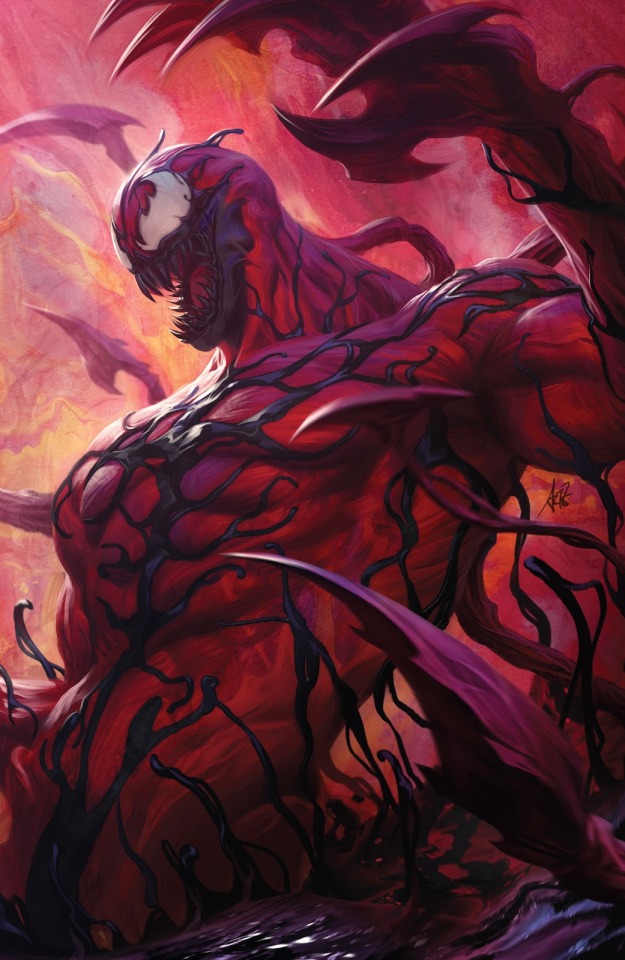
In honour of Absolute Carnage’s beginning I present you with the best Carnage stories if you want to get into and have fun with the character.
My picks here are intentionally excluding anything from Donny Cates’ era partially because his work isn’t finished yet and partially because my hope is this list will act as a primer for people who want to test the waters with Carnage and see if Cates’ current work is worth their time.
This list isn’t ranked at all and nor is it a list of stories that are essential to understanding Carnage’s broad chronology. Like if you read these on their own there will be gaps that will make you wonder how we got from A to B.
Rather this list is intended to give you a general idea of who Carnage is, the types of stories he has or can be used in and what are among the best stories from the character’s POV.
1. Carnage Origin (ASM #344-345, 359-363)

There are some writing issues with this arc in relation to the F4’s use in the story. However if you put that aside and just focus strictly upon Carnage himself, in many ways this first Carnage story gives you everything you need to know about the character.
We learn most of Cletus Kasady’s backstory, where his symbiote came from, his general philosophy towards life and the dramatic hook he presents as an antagonist.
That is to say what is someone was an unrepentant psychopath...and then got superpowers. Specifically the same powers as Spider-Man’s then most physically intimidating and scariest enemy...but taken up to 11.
Are there deep psychological layers to Carnage?
Absolutely not.
But that is very much the point.
He’s chaos and death wrapped in black and blood and complete with Freddy Krueger humour and a taste for Metalhead anarchy.
The art is simply stunning, the action is top notch, Carnage’s various abilities and ferocity is expertly sold to readers and just to hammer the seriousness of the situation home, Spidey needs backup from his most dangerous enemy to even hope to bring down Kasady.
So whilst unfortunately not perfect, it is a perfect introduction to the character.
Honourable Mention: Maximum Carnage
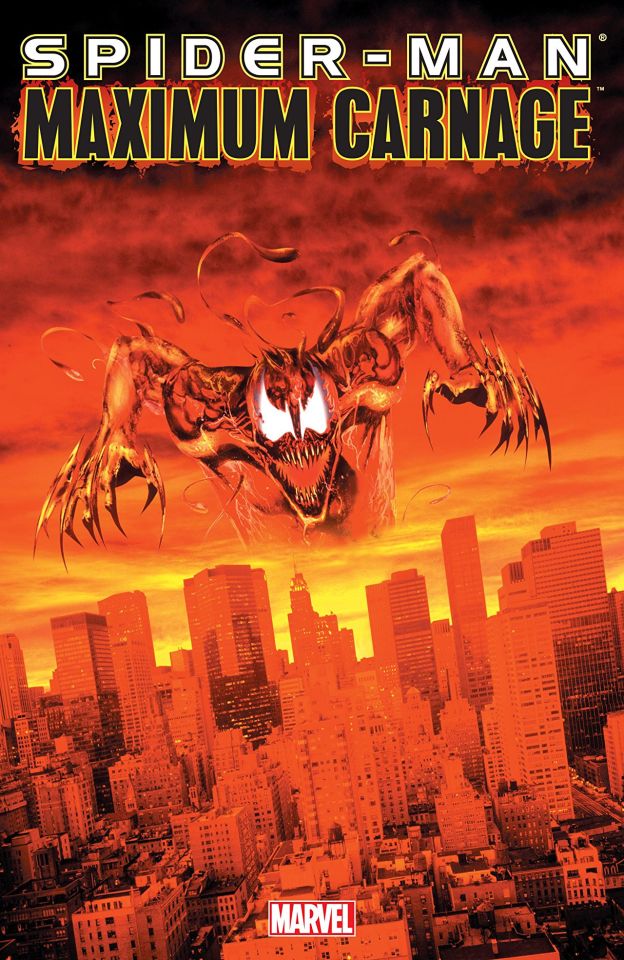
I do not recommend you read this if you are new to Carnage, Spider-Man or comics in general. Maximum Carnage is enjoyable to certain fans but for most is something of an endurance test.
However it must be mentioned as it is undoubtedly Carnage’s most famous story. It doesn’t really give us anything new for his character beyond introducing his on and off again girlfriend Shriek and his ‘kids’ Doppelganger, Carrion, Demogoblin, etc. These characters intermittently show up in Carnage’s lore.
The whole story is a series of repetitive action set pieces...for 14 issues!
If you aren’t brave enough to check this out then perhaps consider reading synopses of it or watching recap videos online (RNS does a good one), just so you know the broadstrokes of the story as it is relevant to future Carnage history and Absolute Carnage is it’s spiritual successor.
2. The Mortal Past (ASM Annual 1994)

Arguably the best written Carnage story within the pages of Spider-Man.
The art is very reminiscent of Mark Bagley, co-creator of Carnage, so visually Carnage looks and ‘moves’ in character.
However the general story, whilst not redeeming Carnage at all, does give us a little more about his past and explores his philosophy from a different angle.
What helps this story is that while it is a Carnage story, the emotional weight of the story is carried by his former childhood friend, allowing for Carnage to neither sell out on his core concept of being a simple killing machine, but also giving the readers something to connect to beyond Spidey and Carnage fighting.
3. Carnage: Mind Bomb #1

Many Carnage fanatics argue this obscure one shot is Carnage’s ‘Killing Joke’. In a sense they are right as this story is the deepest exploration of who Kasady is and why he is the way he is.
We learn little about his past (beyond a few more early warning signs from his childhood) but this is Warren Ellis’ point. The story is oddly meta as it presents us with a psychiatrist who is looking to unravel the layers of Kasady’s mind, only to learn there really aren’t any.
He is simple. That is the point. He simply sees society and life as a joke, a big lie and that savagery lies beneath the surface. He illustrates this by driving his doctor utterly mad.
This story works because though it takes place in a superhero universe and features a super villain, there is no hero here. There are barely any good guys to speak of.
Rather this issue is in effect a horror comic, the first time Carnage was ever used in this way. This is reflected in the art work, which is definitely R-rated and depicts Carnage very differently. He’s essentially solid red and leaner, more skeletal even.
A good way to look at this story is as “What if Freddy Krueger or Jason Voorhees sat down and explained to you why they kill people’
Gory and not for the faint of heart, but this issue is the best story you will ever read that spells out for you who Carnage is and why, from his POV, he does what he does.
4. Web of Carnage (Sen #3, ASM #410, No Adj #67, Spec #233)

Carnage appeared a few times in the Clone Saga but this is his best outing. In general this is one of the more fun and enjoyable Clone Saga/Ben Reilly stories. But as a Carnage story it’s unique as it focuses much more upon the symbiote than Kasady.
The premise is simple yet effective. The Carnage symbiote bonds to Spider-Man/Ben Reilly and he must resist it’s attempts to control him or tempt him to violence, which includes urging him to murder Peter Parker!
The meat of the story is in parts 3-4 when we see Ben’s internal struggle against the symbiote. Visually, the art is not consistent because of different artists, but they are all decent-great and the design for Spider-Carnage is so iconic it was adopted for the finale of the Spider-Man 1994 cartoon series.
A simple yet fun story!
5. Carnage: It’s a Wonderful Life #1
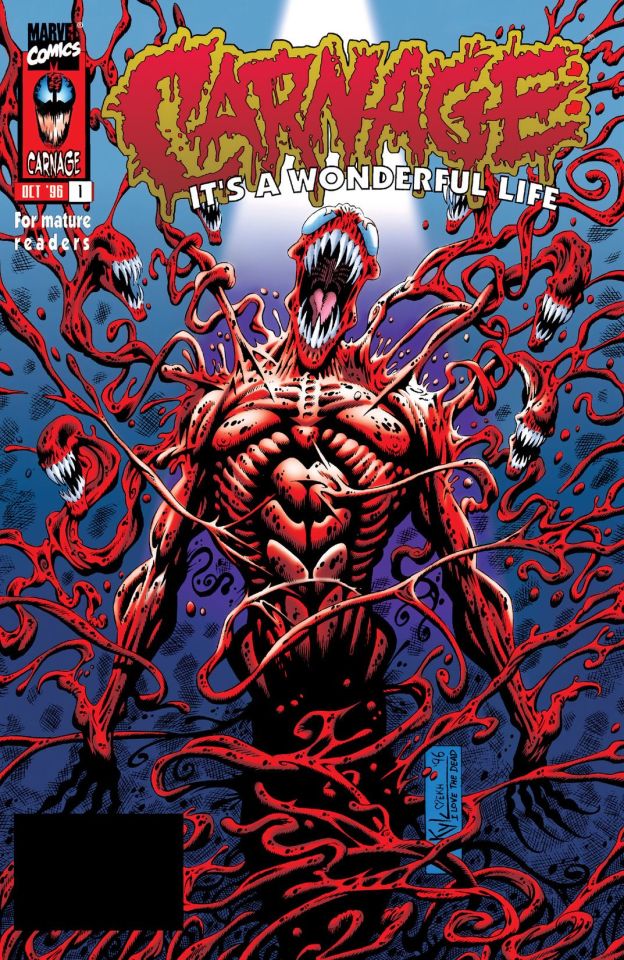
I recommend this tentatively.
This is because it technically speaking covers much the same ground as Mind Bomb but isn’t as good. I suppose if you read this first you wouldn’t get that impression.
Nevertheless, It’s a Wonderful Life is an even longer and more literal look inside Carnage’s head. Psychedelic, twisted, macabre and full of dark humour the story just about pulls off it’s horror premise. It feels like something out of a 1990s Dark Horse comic.
The one thing that this issue has over Mind Bomb is that it makes an astute observation about Carnage’s core philosophy I don’t dare spoil.
Honourable Mention: Venom vs. Carnage #1-4

This story is in general pretty fun but doesn’t give you much of anything new for Carnage beyond him teaming up with Venom and the introduction of his spwan Toxin, who is a pretty cool character in his own right.
More significantly it was the first major time Clayton Crain drew symbiotes and he’d go on to have one of the most memorable visual takes on them ever.
6. Family Feud (Carnage #1-5, by Zeb Wells)
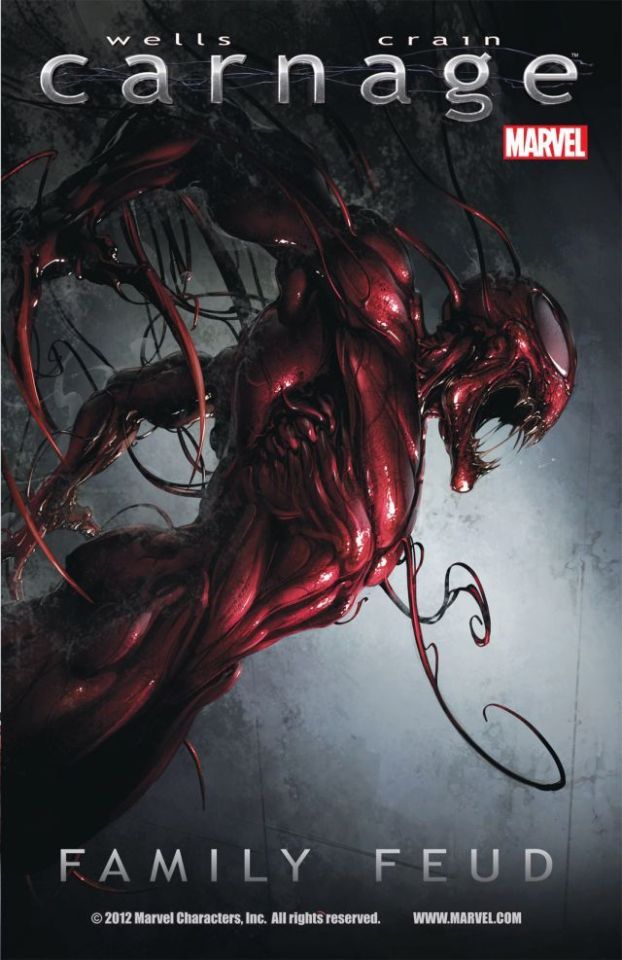
I’m not fond of most of Wells work and have issues with this era for Spider-Man. But when looked at as a Carnage story first and foremost, this series marks an important point in the character’s history.
At the time Venom had transitioned into a more heroic figure meaning Carnage, much as he was back when he was created, was pushed as the face of evil symbiotes within the Marvel universe. To that end he began to have a string of his own mini-series just like Venom had in the 1990s.
In many ways this mini-series is playing cleanup, returning the Carnage symbiote and Kasady to Earth after their presumed death in New Avengers #1. The series however also seeks to build a foundation from which future stories can be told and to that end reintroduces Shriek and Doppelganger too, sets up Carnage’s daughter Scorn.
It does all this pretty effectively to my recollection and has great art by Crain to sell everything.
7. Carnage U.S.A. #1-5
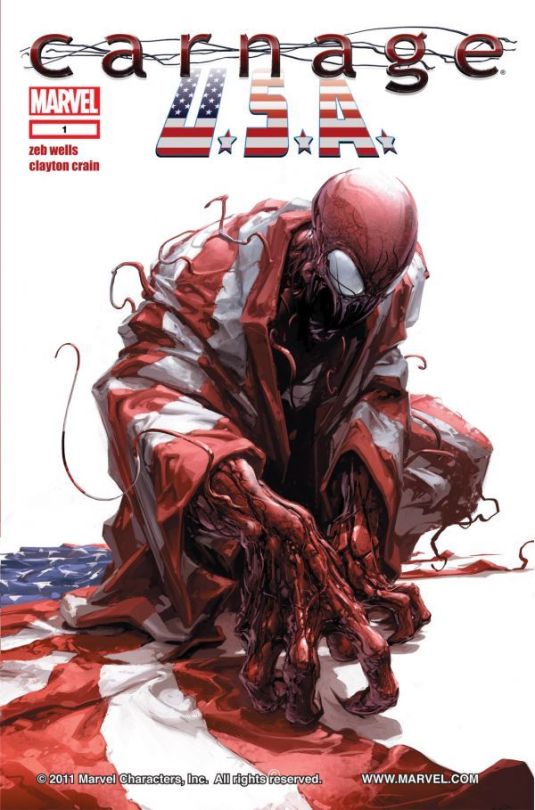
Zeb Wells in this story tells a story that could have been an event crossover but mercifully was not.
He and Crain return to deliver arguably the most ambitious Carnage story up until then, involving him infecting a whole town with his symbiote.
This again feels very much like a Dark Horse horror comic at times but still contains superhero elements and tones a plenty, finding a decent balance between the two.
Wells continues to world build by reintroducing many of the other Venom spawns (Carnage’s ‘siblings’) and uses them to great effect along with Agent Venom Flash Thompson who meets Carnage for the first time in this story.
Carnage himself is just very on point with his twisted plan and machinations, with this tale being among his more memorable villainous feats.
8. Deadpool vs. Carnage #1-4
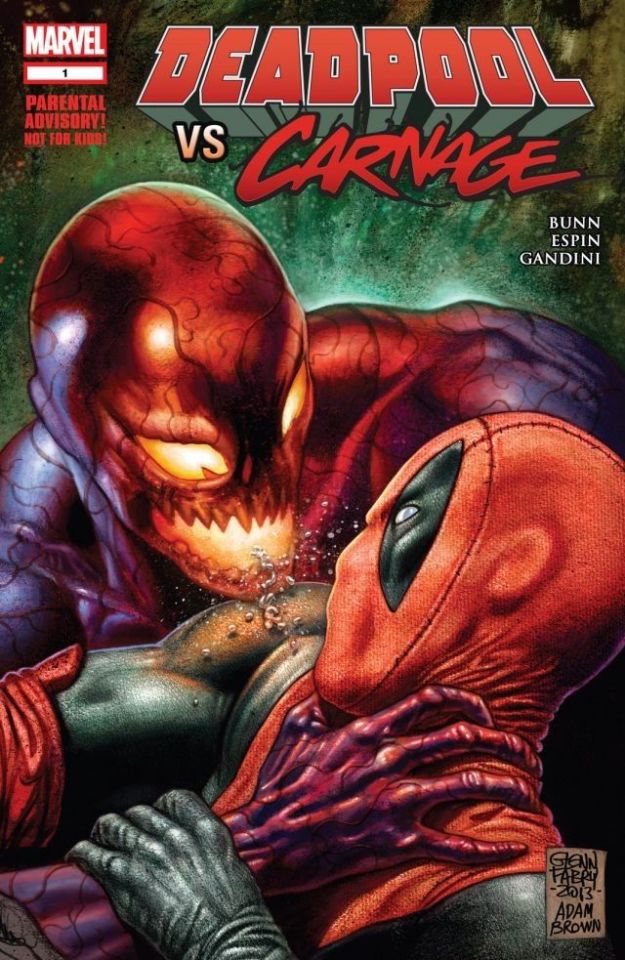
Have you ever seen a Road Runner cartoon? Have you ever seen parodies of Road Runner cartoons by late night animated shows where they use dark humour to make the antics more bloody and violent?
That is essentially what this mini-series is. It’s two wisecracking, red and black clad over the top characters going at it in wacky and violent shenanigans.
However there is also poignantly some stuff in the story that even makes Carnage question his life philosophy in one of the most oddly clever takedowns of his character ever.
9. AXIS: Carnage #1-3

This story has it’s issues, in particular with who it’s villain is, but that’s more a problem for Spidey and Venom history.
As for Carnage himself this story comes recommended for it’s sheer novelty.
It’s Carnage...but as a...good guy?
The premise of the AXIS event was that certain heroes and villains were ‘inverted’ so that they went from good to bad and vice versa.
The wrinkle in this though is that Kasady is still Kasady. He’s still violent, insane, wisecracking and has a warped sense of morality, it’s just that now he finally has a sense of morality. He is sincerely trying to do good he’s just not all that aware his methods are somewhat counterproductive and extreme.
10. The One That Got Away, World Tour, What Dwells Beneath, (Carnage #1-16 by Gerry Conway)
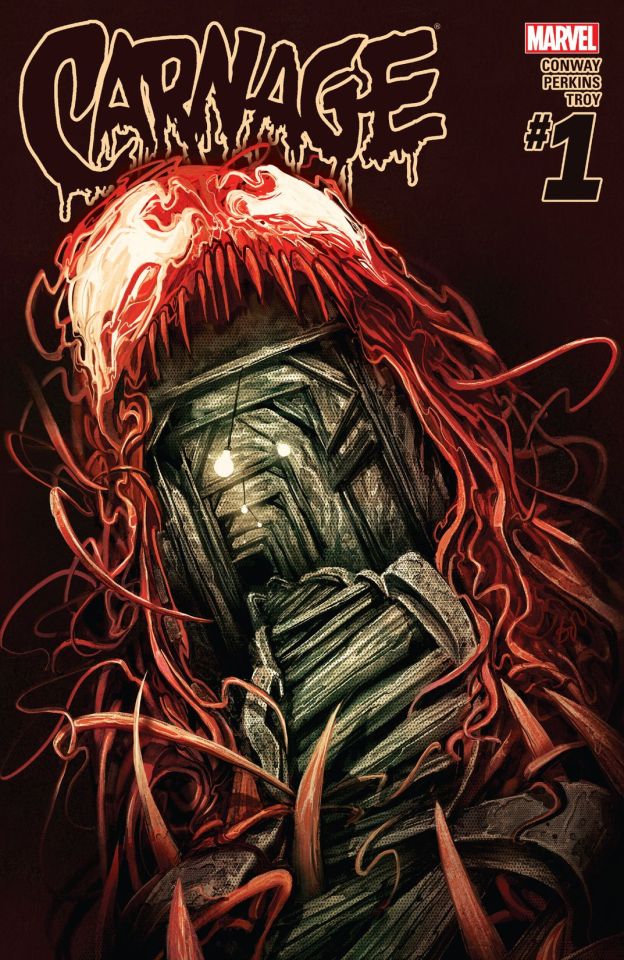
Mind Bomb and It’s a Wonderful life were the first Carnage comics to embrace the use of the character for horror, but Conway’s Carnage picked the ball and ran with it.
Conway said he was in essence doing Tomb of Dracula with Carnage and it shows.
The series revolves around Carnage but the real main characters are the anti-Carnage taskforce assembled to put him down, giving us grounded relatable characters to connect to whilst we follow Carnage’s slaughter. There is a surprising swerve in the story where the story goes from a simple slasher movie style horror into full on Lovecraftian style horror which propels the consequent arcs of the series. The ending is rather rushed and weak I must admit, but the ride getting there is arguably the best crafted Carnage story ever.
#Carnage#Cletus Kasady#carnage symbiote#Maximum Carnage#Absolute Carnage#Mark Bagley#Gerry Conway#Zeb Wells#Lovecraft#AXIS#Tomb of Dracula#Warren Ellis#Deadpool#Venom#Eddie Brock#Clone Saga#Ben Reilly#Spider Carnage
356 notes
·
View notes
Text
Writer Notes: The Wicked + the Divine 44
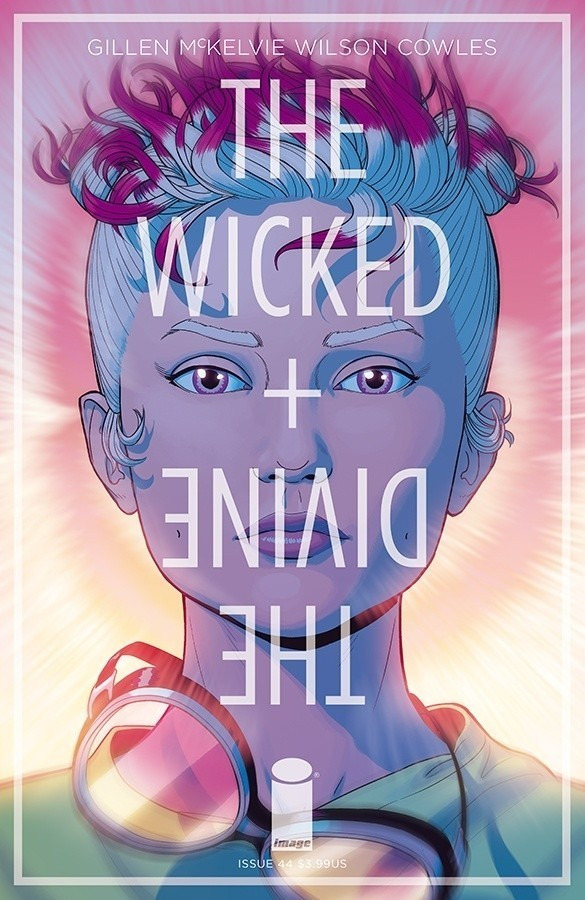
Spoilers, obv.
I'm aware that this is either going to be a relatively short one or an epic one. The risk of the latter is that rather than just talking about the issue, for the first time I'm free to talk about the series as a whole, and so talk about some of those other choices. There'll be some of that, but it would warp the nature of the notes, and give some false perspective. I can talk about it being over now, sure, but talking about it all means I'm not talking about this element. Not least because I can't talk about it all – there's still the question of issue 45.
But still. There's a lot to talk about, and a lot of hard things in here to do. We knew where we going, but the devil is in the details. The devil's everywhere.
Jamie/Matt's Cover
Minerva finally gets her head-shot. I was a little worried that people would realise exactly what was happening to Minerva here, but I didn't see anyone realise she's falling, and speculate why. Of course, I knew what it was and couldn't not see it. That's how it works.
It's a striking last image though – this is an especially blank glance, in the middle of all the motion. Matt's pink/white nimbus is really powerful too.
Emma Rios/Miquel Muerto
Emma's one of our favourite artists, and we were so glad that we managed to get her before the end. Emma's always someone who gets this evocative drama of it all – this is obviously a momentous cover, but you don't know the moment until reading. Laura and Lucifer being a core relationship, and the hint of leaving. Miquel does strong, atmospheric things with the colours as well. It's a great cover to end the story on. On - Pretty Deadly is back on the same day as 45, and I can't wait. Gets!
IFC
In terms of minor things we did which have a big emotional effect, changing the gods' names to their human names was certainly one. It sits there and stings.
Page 1
This issue is particularly tightly wound, so we set the clock on the issue in this one page.
I had a couple of people wonder where the cops came from. I presume it's because the delay in publication – the "we have to go now because of woden's tape has revealed we're almost all complicit" is the only reason why they went for Minerva immediately.
For a page that's so tightly wound, Jamie does some great establishing here. Opening panel with the fire in top of Valhalla, to link to last issue. A shot with all these people in it – a character beat, and three extremely dialogue low panels.
Page 2
Riff on Better The Devil You Know.
The weird rhythm in WicDiv is the arcs-which-take-place-in-a-very-short-time and arcs-which-take-place-over-months. Faust act, Rising Action, Imperial Phase II, "Okay" are the over-a-short time. Fandemonium, Commercial Suicide, Imperial Phase I and Mothering Invention are the extended ones. The closest to one which does both is Faust Act, which spreads its action over a week or two.
Page 3
Lovely stuff in here with Jamie, in terms of character work – obviously this is Lucifer hamming it up, but seeing individual responses around the room is a hell of a thing. Minerva's a total mess here.
Valentine giving up clever insults at this point is probably a thing.
Page 4-5
"Bothersome" is a very Lucifer word. The expression in panel 2 is also key Lucifer – that eye-roll of it.
Laura's captions also arrive mid way through – key, as they're clearly going to be key. I was thinking of having them at the start of page 3 as well, but we can let us live in the moment.
Laura's performance tentacles is a lovely panel – seeing how Matt works the colours on the space. The blues fading to white, the reds. Honestly, this is making me miss working with Matt already, and seeing how good he and Jamie are together.
Callbacks here to Lucifer in the first arc – the cycle of it all.
"There were two girls in hell" makes me well up. |It's one of my favourite Jamie expressions in the issue.
Page 6-7
When planning the larger structure of WicDiv, I was aware that I made certain calls in hope I would be able to save people. The early "death" of the Heads was actually a way to protect them. I was aware that characters who were in play were far more likely to die, as they had more chances to do so. I knew I could likely save the heads, so by making them heads, I made it more likely.
I originally planned for Dionysus to die, but I couldn't bear it. His hubris was real, but the idea that someone could give so much without anyone really caring or doing something for him was too heart breaking, even for me. I realised during Rising Action that I could actually save him – the pieces were already in play, and I just had to lean into those relationships to lead to Baph's choices. At the start, I wasn't sure where Baphomet ended in year 4 – part of me thought he'd survive, as I didn't have that final beat for him at the start. That I didn't have a hard end for Baphomet always made him open to the story finding another purpose for him – which is an end which I can't imagine any other way now. WicDiv is an awful necessary machine.
That applied to Lucifer too. She was a darling, obviously, but she was always going to be trouble. Part of me was aware that she could come back and almost immediately get killed again. I'd like her to make it out, but it was possible she wouldn't.
So, as I said last time, when I realised she was the final opposition I was pleased – that was perfect to the themes and the structure.
I wrote in my synopsis that Laura uses a performance to touch Lucifer and convince her into renouncing her godhood, and left it at that.
There it sat until I came to script it.
Because, in all honesty, I had no idea how Laura was going to convince Lucifer to give up her godhood. I just trusted that there would be some way Laura could reach her. Or, really, I hoped there was – because I knew if I wrote something that didn't feel convincing to me, I wouldn't do the scene. Lucifer would have died instead.
So, the day came when I was scripting this sequence, and I started writing, and wondered what the performance would be, and I just wrote "Laura descends the Ananke head sequence and drags Luci back."
Then I leaned back, a little shocked, because that was clearly right, and so clearly fit with what the series does – a final deconstruction of one of our core visual icons, giving a new way to look at the sequence and think about it. It was just there. As if it was there all along. Or just the sort of thought that emerges when you've been obsessed over this fucking thing for five years.
I'm aware of the weird resonance as well – Laura's finding a performance to save a friend is me finding a performance to save a character. WicDiv was a weird book.
Jamie and Matt go to town, of course – the melting faces are just painful, and wonderfully done. The fleshy reds, the fires. How Clayton uses the captions across the page to play with pacing...
I originally suggested we do it completely as the WicDiv spread, with Laura crawling across the centre spread and making her way up – that it would be treating what is meant to be two columns as a space was decided to be too much, so instead we went with flipping to a subjective perspective on a space that we've only experienced from a single objective outside viewpoint. That's got magic too.
Page 8
A long time to get to this kiss, right?
We moved the dialogue around a little to nail some moments – we had the magic effect on the final panel so the transition to the next page wasn't too much.
The annoyance of Eleanor in the last panel is just my everything. I described it to Jamie by using a metaphor of me in my early thirties, having split up with an Ex, and torn between various places, including seriously wondering whether, after everything, the simple answer to my sexuality stuff was that I was just gay. How annoyed I would have been, after all those years, if it was that. Just a "Oh, FFS. I'm just gay! Why didn't I get that earlier? Why have I wasted all this time? What a fucking fool I am."
That.
Page 9
Repeat of core WicDivian imagery, turned to a different purpose. After these magificent godly reveals, we do this very normal world.
Yeah. This would have been a happy place to end the series.
Page 10
Laura wants to be better, of course. It's easy to say you want to do better.
A+ Cassandra-ing in the background there.
Page 11
Now, Minerva is dead in a few pages time, and she is a genuine monster, trapped in a system of her own making. But I didn't want to send her into the void thinking she had that horror awaiting her. I can't forgive her, but I can give her a little peace.
Title drop, of course, with a wonderful expression by Jamie. There's a lot here.
Okay, let's do this.
"Okay" is a phrase that's haunted WicDiv. We've come back to it multiple times – it's a fascinating word in the English language, and has caused problems for people translating it, in the mixture of ambivalence and optimism in it is really tricky. Clearly, we use everything inside the word.
It wasn't my Dad's last words, but it's the last exchange I remember with him. Everyone else was out, and I was helping him back to his seat. He says to me.
"Son, I know this is strange, but I can't help but think it's going to be okay."
And I can almost imagine my eyes bulging out of my head, as I wanted to howl at him: no, Dad. It really fucking isn't.
This comes up almost verbatim in the first arc, with the exchange between Laura and Lucifer before she breaks out. The series is about many things, but my Father's death was the core inspiration for it, and that "It's going to be okay" haunted me and it.
I don't think this is what my Dad meant, clearly, but it's how I've ended up metabolising it. I've been signing "It's going to be okay" when I sign Faust Acts, partially as it's the WicDiv phrase, partially as a secret-promise-that-they-won't-all-die-and-there-is-hope and partially because "When death comes, it's okay" is that buried in it. If I had to boil the book down to a sentence, it'd be it. It means different things depending how you look at it. That's all I've got.
Page 12
I talk about Solving The Equation of the third year, and Dio being in play for this section is absolutely part of it.
That first panel. I said that the cast were all people I'd have killed to be at various stages of my life. Umar is someone I try to be now. I don't succeed, but he's a worthy goal. Kind is not soft and all that.
While the silent panel is something you've all seen before, it's worth highlighting how good Jamie is. The favourite gesture of the scene is the eyes upwards of Cassandra – I don’t remember Jamie using this angle before, and it's really striking. I suddenly miss that I won't be working with Jamie again for a while. Have fun, Jamie. You were the best.
And now, this.
Page 13-14-15
"It would take a real monster to kill a kid" is one of those lines that have been sitting in the files since the beginning.
There was a fan artist in the WicDiv community early on who kept on doing these totally charming portraits of Baal and Minerva playing around in a big brother and little sister way. Every time I saw them, I felt both love for the art, and a sadness. "In four years time, you are going to have a terrible day."
That's one of the weirdest things of the last four years – that. Knowing that stuff is out there.
Looking at this at a little distance, I see the elements in – the standing on the edge, the "Please Don't" and all that. I sigh. This is awful and upsetting and that page turn is one of the hardest in the series. I wish Valentine would forgive himself, but he couldn't.
This is the sort of thing I want to write a lot about, and want to write nothing. I think I'll keep it as just the facts, in terms of trying to plot this.
Occasionally you get to a knot – I knew Valentine had to kill Minerva, that Valentine couldn't bear to live after that was done and that Minerva had to die after Baal gave up his powers. How to you put those three together, without introducing something else.
C asked "Where does it happen? Could it happen somewhere high?" and the rest was there. Falling being the repeating WicDiv image as well.
I think I pictures this actually side on, without the drop. Jamie's choice is better, just because of the eyes.
The three panels is something we're returned too, but choosing the distance was key. You know it's there, but I didn't want to revel in the dead bodies. This is a different kind of death to many of the ones in the book, and has to be treated as such. Any more blood than shows they're dead would be obscene.
I sigh again. I note that Matt does the lights on the guns perfectly, but I want to highlight craft. The shot of eveyrone waiting is a huge thing – Inanna's grief, Dio stepping in, and the crossed arms of Cassandra...
16
I think it was when I was plotting the second year at WicDiv that I realised that I couldn't see a way out of this which didn't involve the majority of the cast ending up in jail for a while. I was okay with that, as it made some sense. It's thematically resonant for a few ways – it's a choice which shows their acceptance of their acts, and their actual humanity as well as an understanding of their power, and lots more.
However, due to all the straight, white characters being dead, it does mean that a all-queer all-PoC-minus-Lucifer cast going to jail, in the current jail system. That said, while far from perfect, the UK is not the US. I don't think I could have written this ending in the US. Even in the UK, I safety-proof it conceptually as much as I can.
They are all queer, and almost all PoC... but they are also superhumans (and mostly rich.) They have a degree of power, and options which are not open to other people... and it is their one chance to try and navigate this space with no-one else (either them or other humans) getting killed. It's their last chance to act in good faith to the rest of the species.
I wouldn't trust the system if they were people without their resources. They're not. And this is the least-worst choice I can see.
I'm sure some of you will disagree with me on that.
17
More safety-proofing – Voluntuaryism is an anarchist idea. "The only true order is voluntary order" basically.
18-19-20
This is a lot of space for a sequence which is relatively minor dramatic weight, but as we segue towards the end, we want it to breathe a little. Plus there's the matter of the page turns – the previous interstitial was about pushing that as well, so both the "surrender" and Laura's final headshot are on a turn.
Matt's lighting in this sequence is wonderful – I said to Jamie that I was thinking of almost suggesting we're changing genre before Laura steps in. It's a "The special forces go after Batman" sort of sequence. I was thinking of the one from Batman: Year Zero, which is some top class special forces entering darkened environments.
Another moment of the weird-colouring-in-a-balloon, and the actually living in the moment.
Taking the guns is more safety-proofing, showing they are not acting in blind faith of the system. That Laura can take the guns also shows that Laura likely could walk out of prison any time she wants, and the rest will be able to do the same too.
(Not that the people in power know they don't presently have access to their big ones, of course.)
We originally has Cass shouting that final line, but had it much more matter of fact. This is kind of past shouting.
21-22
Yeah, this is calling back all manner of stuff. Back to the courtroom.
Jamie asked me a lot about the final expression, as is only right. This is a story where we've used head shots a lot, normally with pose. This is something else.
23
Worth noting that Laura couldn't be sentenced to life imprisonment. She's 18 so would be sentenced for "custody for life". Not that the story actually says what she's been sentenced to that either – we cut before the sentence is given. Don’t expect a firm answer to that in next issue either.
But they all have been sentenced to life, in the obvious metaphorical way. Laura has been depressed and self-destructive to the point of a death wish throughout. At the end, she's decided to try to live.
I count that as bitter sweet, and I count that as a win. I'm proud of her. I'm proud of them all.
I'm in tears now.
24-28
And we were when compiling the letters page. Thanks you lot.
29
Jamie and I both had really intense feelings about the final cover. It's clear why we've kept it secret (it gives away Laura survives) but to see this young woman we've been writing about older was incredibly moving.
Laura was 20 years younger than me at the start of WicDiv, and she's 20 years older than me at the end. Feeling suspended between the two poles, identically. The duality of it, one more time.
I love this cover so much, and I loved these characters, this book, you lot.
Thanks for reading.
190 notes
·
View notes
Note
If someone wanted to get into persona, what is the best game to start with?
to be honest, Persona is kind of nice in that it doesn’t matter a whole lot where you start, since each game is a relatively self-contained story which only has brief mentions or cameos of previous entries! some elements of the lore make more sense if you play certain games before others, but it isn’t anything drastic enough to impact your enjoyment. Hell, I started with Persona 5 and was just fine. So I guess I can just sorta talk about the pros and cons of each game as an entry point to the series! I can also briefly describe their premises in case a particular one seems more interesting, which could help someone with deciding where to start.
this is gonna be long, so I’ll put it under a read more.
Persona 1/Revelations: Persona is the only game I wouldn’t recommend playing first. Its mechanics are pretty outdated and not reflective of the rest of the series, and it’s relatively short compared to the others as well. Not to say that it’s not worth ever playing! In fact, from my understanding it has wonderful characterization, an engaging plot, and lays important groundwork for the franchise’s worldbuilding. I just wouldn’t recommend it for getting a taste of what the series is like.
Persona 2: Innocent Sin is the first of the dual entries for the Persona 2 duology. It has some of the same cons I mentioned for the first game; it’s relatively old, so its mechanics are a little outdated, and it plays more similarly to an SMT game than the future Persona entries do (for example, the story is fairly linear and occurs over the course of a few days, whereas later entries are strung out over a year). It is a little more refined, though, and the formula is starting to get there. It also has, in my opinion, some of the best character writing in the series.
P2IS is a story about how strange occurrences are brewing in the city of Sumaru because of a phenomenon where rumors actually influence and/or become reality. A group of high schoolers get tangled up with a mysterious man named Joker, who can supposedly grant wishes and, for some reason, seems to hold a very personal grudge against them. They discover their ability to call upon Personas to defend themselves from the demons at his command, and soon end up teaming up with journalist Maya Amano to get to the bottom of Joker’s identity and the source of the rumors which are warping the city. Over the course of their journey, they slowly start to piece together their past in order to figure out why Joker seems so invested in them.
Pros: - Stellar character writing- An intriguing, interconnected plot which is a bit of a rollercoaster but a lot of fun- Lays the groundwork for lore in the Persona series (most importantly the existence of Philemon and Nyarlathotep, as well as the origin of the Velvet Room)- Incredibly mature takes on the impact of trauma and familial abuse (TW for both of those things though)- Canonically bisexual protagonist with a potential same sex dating optionCons:- Unavoidable random encounters and really grind-heavy, as most 90′s jrpgs go- Outdated mechanics that aren’t really reflective of future Persona entries- One of those wiki-heavy games: it’s damn near impossible to unlock certain character interactions or personas without use of a guide- The second game in the Duology, Eternal Punishment, isn’t nearly as accessible to English audiences
Persona 3 is where a lot of the series formula originates from! It’s also my personal favorite, but I’ll try my best to be unbiased describing it. Small note: I recommend playing Persona 3 FES specifically, since it refines a lot of the things that were clunky in the vanilla version, adds more character content, and features a post-game which answers a lot of questions.
P3 takes place in a coastal city called Iwatodai at the beginning of the school year, where the protagonist moves in as a transfer student after being bounced around in foster care for ten years following an accident which killed his parents. Upon arrival, he experiences the strange phenomenon of the Dark Hour: an extra 25th hour in the day where people are transformed into coffins and monsters roam free. Technology doesn’t work during this hour, and anyone not protected by a coffin is violently attacked and seems soulless the next day, a condition local news dubs Apathy Syndrome. A select few people have the potential to stay conscious during the Dark Hour and protect themselves by use of a Persona, and these people make up a unit called the Specialized Extracurricular Execution Squad (S.E.E.S.). The protagonist joins, and the game follows their investigation of the phenomenon. It’s considered the darkest entry in the series, and for good reason: “memento mori” is right in its introduction. The game focuses heavily on themes of death, what it means to be mortal, how people deal with being confronted with their mortality, what the point of life is, and much more.
Pros:- Introduction of the Persona formula: school life and dungeon exploration which requires time management on a linear calendar, the knockdown/1-more feature in combat, all-out-attacks, social links. Starting with this game may actually be the best way to go gameplay-wise, since coming back to this game after playing later entries makes it seem clunky.- Dungeon-crawl style of gameplay, which is a lot nicer than random encounters. You explore randomly generated floors and choose when and where to ambush enemies.- Excellent character arcs which enrich the game’s narrative- A dark, mature, and interesting story which explores human natureCons:- Still an older game, so some controls are clunky. One game mechanic in particular that many are frustrated with is the inability to directly choose what moves your teammates will use, instead requiring you to use Tactics to direct how the AI should behave.- Probably has the worst pacing issues out of any game in the series. There’s an entire calendar month where you do basically nothing.- The post-game is grind-heavy and long for the amount of story it offers. Some people just recommend watching a playthrough.- Features an uncomfortable transphobic skit towards the middle of the game.
Persona 4 is a refinement of many of the features of Persona 3. The best version to play is Persona 4 Golden, since it has a lot of extra content, but it’s vita exclusive and I’m stuck with vanilla :( Vanilla’s still fine in my experience, at least!
P4 takes place in the small town of Inaba, where the protagonist has transferred for a year to live with his uncle and cousin due to his parents leaving the country for work. Shortly after his arrival, a bizarre series of serial murderers start to occur where the bodies are found strung up on telephone lines. There’s also a rumor that looking into a turned off television screen on a rainy midnight will reveal your soulmate; this rumor is referred to as the Midnight Channel. The protagonists and friends inadvertently discover a parallel world which exists alongside Inaba, which can be entered through televisions but which can’t be exited without the help of a mysterious denizen named Teddie. They discover that these worlds are linked; people who show up on the Midnight Channel turn up dead in the real world shortly after, and the weather is inverse to Inaba’s. They discover that this is because someone is throwing people into this world, who are then unable to escape, and that the Shadows living in it become violent when the fog lifts (inverse to when the fog settles in the real world). This world also has an interesting quirk: people who enter it end up confronting their own shadow, which is a manifestation of the parts of themselves they repress or deny. Denying your shadow leads to it attempting to kill you, and this is likely what caused the deaths of the first victims. The protagonist and team discover that confronting and accepting your own Shadow, however, turns it into a Persona which you can then use to combat the monsters in the world. Equipped with their unique knowledge, the team sets out to save victims, solve the murder mystery, and learn how to accept themselves.
Pros:- A powerful message about the importance of seeking the truth and accepting all facets of yourself- An absolutely incredible murder mystery with clever plot twists and high stakes: getting the true ending is actually difficult if you don’t know who the murderer is, and you’re expected to understand the themes of the game and the characters in order to get it.- A nice in-between for the mechanics of P3 and P5: it’s pretty easy to transfer to either one after playing this one. (also introduces the ability to control party members directly, thank god)- A TON of spinoff content if you find you enjoy the characters and setting- Probably one of the best games in terms of understanding the overarching lore of the series, since it explains how Personas and Shadows work in much more depth than other entriesCons:- Has sort of a wonky difficulty curve. The first couple dungeons are honestly kind of a pain in the ass because of how level scaling works, and it takes a little while to level out.- The character arcs aren’t quite as well-written as previous games, due to the ultimate personas being associated with social link completion rather than events in the plot.- Oh god, such clumsy handling of LGBT topics. Plays around the idea of a gay narrative for one character (Kanji) and a trans narrative for another (Naoto) but ultimately just ends up playing up stereotypes and then backing out before doing anything “risky.” Another character in the party is pretty homophobic to Kanji for a while too, which sucks.
Persona 5 is the most popular in the series for sure, and for good reason. It’s the complete culmination of the Persona formula, and it adds all sorts of stuff to the gameplay and lore. It has a pretty lovable cast, to boot. Not that it doesn’t also have its problems, imo.
P5 features a protagonist who was falsely convicted of assault after attempting to defend a woman from a drunk man harassing her. His criminal record and probation result in his expulsion from his home school, so he moves in with a family friend in Tokyo where a school will accept him until his time’s up. Tokyo’s been strange for a little while now. Mysterious incidents have been causing disruptions for a while. There’s been a surge of “psychotic breakdown incidents” in which people act out unpredictably for seemingly no reason, and on rarer occasions “mental shutdowns” where people seem to completely break and die shortly after. The protagonist and friends get tied up in nonsense pretty quickly when a mysterious app on his phone transports him to a parallel world in which real locations of Tokyo are warped beyond recognition. The protagonist discovers the power of persona pretty early on, which he uses to fight the enemies there. With the help of a strange creature named Morgana, they learn that this is the “Metaverse”, a space in which the twisted desires and perceptions of people are made manifest. It’s a space where a person’s Shadow lords over a “Palace”, an altered version of real-world locations which reflects how that person views the world around them. They also learn that personas are the result of having a strong, rebellious will, allowing you to control your Shadow in combat. By breaking into a Palace, defeating the Shadow, and stealing the “Treasure” at its core, the Palace will crumble and the person in real life will come to grips with the morality of their actions, effectively outing themselves. This is referred to as stealing hearts, and the Phantom Thieves are born; they quickly become infamous in Tokyo, though their reputation attracts unwanted attention, as well as blame… could those breakdown incidents be related to the Metaverse, too? This game focuses heavily on the corruption of society, the abuse and manipulation of people in power, the ways in which our circumstances force us to hide parts of ourselves, ideas of justice, and all sorts of fun ideas of “rebellion”.
Pros:- ABSOLUTELY the best gameplay in the series. The controls are smooth, the battles and UI are streamlined, the visuals are absolutely stunning. This is the one that’s most fun to actually PLAY, bar none.- More of a stealth/heist game than a dungeon crawler, which is a fun spin on the series.- Excellent social commentary on the injustices young people face in a system stacked against them.- A really lovable cast of characters, and social links which actually grant you access to helpful gameplay features as incentive. Cons:- Sort of a small thing, but one of the game’s twists is a lot more fun to figure out if you’ve already played at least one other entry in the series.- Has some serious writing issues. The game has a very strong first half, but then starts to feel rushed the further along you get after a certain point. You can tell that the developers wanted to fit in a lot, but didn’t quite have the time to refine the ideas they implemented.- On that note, some of the character writing starts to regress or even becomes contradictory.- Has a couple instances of homophobia surrounding the Red Light District.
This got long, sorry, but I hope it’s helpful! like I said, you really can start anywhere, and you don’t have to play them in a particular order. Just pick the ones that seem the most interesting and have fun!
27 notes
·
View notes
Text
Watermelon Mom

This is a "Rose is Lion" post. Super long theory Steven Universe meta post. I originally did a brain dump of similar content (Rose Quartz Is Melon Mutt) with more images, if you need to see the scenes listed there are caps there. This is a more organized text version but the other one has more notes on the art.
TL;DR: Lion is sometimes being possessed by the Pink Diamond/Rose Quartz character, and that that explains why he knows secrets Rose didn't tell anyone but also genuinely acts like a cat. At this point Rose “faking” her death twice is in fact more plausible than Lion being a 2-dimensional character or Rose having a secret confidant. Every other character in the series has concrete explanations for their behavior, so why wouldn't Lion. End theory. Below cut is a list of scenes and character design thoughts.
My hypothesis is: Lion's behavior is explained by being Rose (see below), AND it's also explained by being a normal (magical tame and cuddly) lion.
-Based on what we've seen Steven do, a body swap is possible, in which case he could be both Lion and Rose at different times, and there's a reasonable in-universe explanation for all of his contradictory behavior together.
-Lion is the only character of the main group who hasn't really had character development.
-Rose has an unresolved character arc that dovetails nicely with Lion's existence (running from the past, hiding things, reinventing herself and leaving her old self behind, etc).
-Lars and Lion have identical powers and there are things Lion knows that aren’t covered by Lars’ powers that also are characteristic of Rose.
I can’t fathom how it would literally play out in the story, but narratively it makes more sense for Rose to keep her own secrets than reveal them to another living soul, since we saw in A Single Pale Rose that she took pains to even make sure Pearl wouldn’t tell anyone about her past. Lion holds ALL of her secrets. His music is designed with hers. He’s been implicitly linked to her from the start. It also makes more sense that we simply haven’t seen Lion go through a character arc yet than that he is exactly what he seems, when Crewniverse put all this worldbuilding that includes almost every named character around Steven growing and changing in their independent lives. It fits. It fits for a post-Steven learning he is really 100% himself and always was show, even when Steven still has growing to do and personal challenges to face.
While maybe totally bananas to contemplate right now, Rose appearing is no longer an emotional existential threat to the Crystal Gems because they’ve now grown as people and separated their identities from their relationships to her, even though it would still be bananas. IMHO.
I’m gonna just list points below. I'd appreciate anyone's thoughts on how one can interpret Lion as a character. It’s the only explanation that, to me, accounts for everything.
Lion bio
-Rose had several lions during Buddy's Book. Lion appears in the desert when Steven finds him a couple centuries later.
-She also had a secret place in the desert full of secrets that would compromise her secret identity, and Lion knew about it.
-At some point Lion died and Rose revived him, but we don't know more than that.
-Rose put many of her secrets into his mane, including Bismuth, the sword used to perform Pink Diamond's shattering, her Mr. Universe shirt, and whatever the hell was in that chest.
-Only Steven can open the wormhole to enter Lion’s mane. (Presumably it’s a Pink Diamond thing and Rose would also have been able to when alive.
-Steven found Lion in the desert. Lion followed him home and started participating in Steven's life, although he comes and goes. Lion showed Steven things his mom left behind and started to fight alongside him and Connie.
-When Steven went in Lion's mane for the first time, he found a tape addressed to him from his mom.
-That tape is the first first-person appearance of Rose Quartz in the show. The only other one is a nearly-identical tape that appears much later.
-Lion continued to back up Steven and Connie and Stevonnie in fights and act like a housecat at home. Lion stayed behind when the gang went to Homeworld, but otherwise was present for most major group fights.
-(If Lion is in fact the melon dog, he was present for all of them)
Lion powers
Lion ages very slowly, can create warps, use a sonic boom kind of attack, and walk on water. His eyes and mane glow at times and Steven can enter his mane dimension to store objects. Lars and Lion have identical abilities. Steven can travel between them. Lion can run for hours without getting tired, as shown specifically in Lion 4: Alternate Ending, but does get tired out by using his warp magic too much, as seen both times he travels to the moon.
-Absent among Lars' abilities is the ability to locate Steven or intuit knowledge only Steven has. Steven has to bring him care packages and letters and updates for Lars to get the news, and Lars loses Stevonnie in Stranded until they’re able to send out a signal.
Lion travels to places (sometimes, only) Rose has been.
Recap of all of Lion’s travel in the series ep by ep below.
Beach City warping blanket explanation: For now let’s assume both Rose and normal Lion would have reason to know their way around Beach City, Rose from Greg/living there for so long and Lion from hanging with Steven, although Lion likely hadn’t been there before the start of the series. I will be skipping teleportation around the boardwalk and nearby areas for that reason.
-In Steven's Lion, Lion warps independently from the desert to the beach house. None of the gems knew Rose had a lion, so it's unlikely that Lion had been there before, although not impossible.
-In Lion 2: The Movie, Lion brings Steven and Connie to Rose's armory. Pearl later in Rose's Scabbard tells Steven that this is a place only she and Rose knew about, and that it is a secret even from Garnet and Amethyst.
-In Rose's Scabbard, Lion quickly digs up Rose's lost scabbard from where it dropped after Pearl faked Pink’s death.
-At the end of Rose’s Scabbard, Lion also knows when Pearl has run off to the strawberry battlefield and takes Steven straight there, although they are still basically strangers at the time and a point is made of them not getting along in the episode.
-In Cry for Help, Lion takes the team to the Communication Hub, even though he wasn't there with them before in Coach Steven. However, it is shown on the screen of a computer in the moon base in It Could've Been Great, explicit evidence that Pink Diamond would know about it. (Implicitly, Rose was a Crystal Gem and could have known even were she not Pink. But she was.)
-In It Could've Been Great, Lion teleports to the moon base, which Pink Diamond would have been to. Only Rose and Pearl of the main cast had been there before at that point, and the galaxy warp was destroyed before the corruption, well before Lion was born.
-In Lion 4: Alternate Ending, Lion brings Steven to Rose's landfill, a location known to Rose and this time not known to Pearl.
Lion knows secrets Rose took pains to hide.
Thought: Rose repeatedly kept massive secrets even from her closest friends, tried to erase the past and ran from mistakes, right up until she made Steven. It doesn't track with established behavior that Rose would risk exposing secrets (or challenge herself) by telling someone else. Why does Lion know everything, and if he isn’t Rose, how did he find out?
In Lion 2: The Movie, Lion brings Steven and Connie to the armory that only Pearl knew about.
In Lion 3: Straight to Video, originally in Lion's mane are Bismuth, Rose's sword, the flag of the rebellion, the tape for Steven, the chest and the picture of Rose and Greg.
-Bismuth was betrayed by Rose and would upend her reputation among the Crystal Gems.
-The sword and Bismuth's knowledge would also be incriminating evidence in the faked shattering of Pink Diamond, which was covered up by Rose and Pearl.
-The tape explains exactly where Rose went after the rebellion.
Lion also summons Rose's sword in Lion 2, although he doesn't summon other items, with the exception of the landfill key coughed up in Lion 4. Steven claims Lion can’t get into his own mane; it’s true that only the PD gem can open the wormhole and others can’t enter on their own, including Lars and Lion, but we have seen Lion take the sword out at least.
-In Lion 4: Alternate Ending, Lion of course takes Steven to the landfill. This place also holds incriminating evidence.
-The Nora tape left there contains the same information about Rose Quartz giving up her form.
-The location is framed by the ruins of a PD structure and Pink Diamond's ship. Plus all of the junk. Any gem from Homeworld who found this place could piece the story together.
-Also relevant about the tape, as has been noted many times, Rose wouldn't have known whether the Steven or Nora tape was the correct one to leave for Steven until after she gave up her physical form. Greg says even Garnet couldn’t predict what would happen when Rose attempted what she did.
Lion is sentient and has relationships and tries to communicate. Therefore, he can be regarded as a character designed with personality.
Lion acts like a person in some episodes, particularly the Lion eps. He “talks” to Steven verbally in Steven's Lion, Lion 3, Can't Go Back, and It Could’ve Been Great, to name a few. I wouldn't be surprised if some of those instances are meant to be specific lines. He talks to Steven and Connie both in Lion 2. He responds directly to what Steven is saying in It Could've Been Great, Lion 2, Lion 3 and Lion 4 at minimum and takes battle commands from Steven, Connie, and Stevonnie. He takes Connie's side after Steven returns from Homeworld. He expresses affection and annoyance towards characters. He’s visibly grumpy when Steven hides his Thunderbird shirt in his mane. Et cetera, just watch a Lion episode.
Steven doesn't have a magic psychic destiny.
Confirmed in Lion 4. Rose wanted to make a child and she wanted that child to be loved, that's it. The rest of the plot was just the unfortunate coincidence of Rose's loose ends + mostly just Steven, like his decision to talk to Connie (aw) that set off many of the later events with Lapis and Homeworld.
How would Rose sometimes be possessing Lion logistically
I think Steven's powers have been established in a way that this is plausible. I also think sleep might be the trigger indicating a switch between Rose-as-Lion and Lion-Lion, like in the start of Steven's Lion. As a lion Lion sleeps a lot and Steven's astral projection type powers tend to come back to a change in his state of consciousness as well.
-Sidenote, in Know Your Fusion, Sardonyx says her room only exists for as long as she does. Rose’s room has never stopped existing.
Steven's "psychic ghost" powers & that dimension. (pay no attention to Ronaldo astral projecting by the stove)
-In Reunited, Steven sees people's consciousness and their bodies as separate constructions.
-The poofed gems don't have little psychic ghosts but their gemstones are there, for the others it shows their whole body dormant with their personality in miniature on top.
-Steven is able to reach the Diamonds emotionally in that space and get them to recognize his gem. He can communicate, albeit indirectly.
Thought: This could answer the question of "she's gone". After all,
-in Nora’s tape in Lion 4, one of the only lines that has changed in Rose’s speech is “We can’t both exist, but I won’t be gone.” This is one of the two times in the series we explicitly see Rose speak for herself and she uses the same words as Steven’s gem half.
Is it possible that Rose in “giving up her physical form” gave up her literal physical form - her gemstone - without destroying the “psychic ghost” part of her personality? We still don't know the ins and outs of the gem body/personality connection, but we know gems' minds and projected bodies are damaged differently by strong emotions vs. damage to the gemstone vs corruption, and we know they're capable of fusion, which causes an entirely new personality to emerge from two gems who are also their own people.
Steven and dreams
Seen in: Steven's Dream is about Steven having a Pink Diamond dream. Steven, while dreaming, spoke to Lapis in Chille Tid when she was inside Malachite. Steven traveled into Kiki's dreams and changed them in Kiki's Pizza Delivery Service. Steven also had various strange Pink Diamond memory dreams like the ones in Can't Go Back, Jungle Moon, and Together Alone. Steven demonstrably has some ability to get into people’s heads and leave his own, sometimes even affecting what’s in there. Technically he even stopped White by getting into her head ;-)
Body hijacking
-Steven occupies the bodies of two different Watermelon Stevens in Super Watermelon Island, and one in Escapism.
-He also took over Lars's body in The New Lars.
-He doesn't need to take his gem along, but he does need to be asleep in his own body.
-He can do so across great distances, as in Escapism he's in Homeworld at the time.
-Unlike a fusion it is not a new person or a combination of people occupying the same headspace, he takes over completely and behaves as himself but wearing another form.
-Lars doesn't have any memory of what his body has been doing when it is returned to him.
-Both Lars and the Watermelons are organic; we have NOT seen Steven take over a gem's body either like he does with Lars and the melons, or like White Diamond does.
This is where the watermelons come in.
-In Super Watermelon Island, the same melon dog finds Steven twice after he loses the first body he hijacked and appears to recognize him. Originally it comes to him right away, but later it finds him when he returns and is speaking in front of everyone in the cave.
-In Escapism, a different melon dog finds Steven immediately and follows him around.
There is one other character who behaved this way towards Steven when he first appeared - sought him out to act as an animal companion with no independent motivation or goal - and that character is Lion.
At the end of Escapism, the melon dog watches Steven float away while frowning. Steven runs into hazards on the sea, and eventually Lion shows up to rescue him.
I believe that PD-Rose-Lion is also the melon dogs (which also would act as precedent to the body swapping aspect of the Lion/Rose situation for future payoff) and that Lion found Steven on the open ocean because he saw the general direction and region he drifted off in. After all, unlike this rescue, every time he’s found Steven in the rest of the series, there’s an explanation, and Lars with his identical powers cannot find Steven.
But Lion is just a lion. He acts like a cat and eats lizards.
Even though Steven Universe is a cartoon, every character still behaves with an internal consistency even when they're very exaggerated. It's actually part of their cartoonishness that their core traits are emphasized? Only with Lion is there this duality of, sometimes he's more "cat", sometimes he's more "person". Maybe he is just a cat mascot but it feels contradictory to the thoughtful design of the rest of the cast if they chose to make this character totally static while everyone else from Peridot to Sour Cream is getting development and upending tropes and gender norms.
Conclusion: Lion is only sometimes Rose, and sometimes just her very tame immortal lion.
In Steven's Lion, they make a point of showing Lion's eyes glowing at certain points before he takes action in a more motivated way or responds to Steven. This also happens in Rose's Scabbard and It Could’ve Been Great. Across Lion’s episodes the glowing eyes are usually accompanied either by use of another magic power (mane) or by a switch from more catlike behavior to more characterlike behavior. I think this might be a body swap visual indicator.
Characters are designed with motivation for their behavior. There’s a reason for every design decision in the show.
So, ok, let’s say Lion's behavior is motivated by caring for Steven. But what about when he first found Steven, then? Was he just really loyal to Rose and grew to love Steven later? If he’s just Lion, why did Rose trust him with the secrets she hid from everyone else?
If we assume Crewniverse has an explanation for character motivations, even the animals (Pumpkin! She loved Steven but learned to fear death more. Now it has her. RIP) would the backstory around Lion’s death and revival explain his choice to protect Steven as, for example, out of devotion or a debt to Rose?
Would that explanation track with the other messages in the show, after the four main cast members have finally divested of Rose-dependent personal narratives? Wasn’t that kinda the whole point? If Lion really is just a mascot, do you think the show overlooked the obvious implications for the sake of having a cool magic animal, or might there be a reason he is the way he is?
Also, we see Lion’s personality. Does Lion really not have a character beyond his role in Steven's life? Is some connection to Steven's gem compelling Lion or inspiring magical animal affection? I can see that there are a lot of options but I don’t believe these explanations are thematically consistent in Steven Universe. It doesn’t quite track with the level of detail and lore put into everything else.
His episodes are all about Steven and Rose. His behavior is motivated by a) being a cat or b) being helpful to Steven and protecting and teaching him.
The only explanation for his behavior is that he was clearly connected to Rose and therefore he has some kind of magical connection to Steven and/or Rose and/or the gem itself.
If you think of Lion as a character, that means he's been helping Steven for a reason. What is the reason in this case? His knowledge and behavior tracks with what we know of Rose Quartz's character, and an alternative explanation tends to contradict it in equal measure. Rose is the other major character who is treated differently than most of the cast in terms of character arc.
The most obvious explanation makes the most sense at this point. Also, this would really mess with Steven. It would dig up so many of the personal issues he has been pushing aside. And it sounds like that’s what we’ll be getting in Future so wouldn’t it fit?
Link to sound clip It also struck me that in this podcast episode, when they answered questions about Lars and Lion they were excited and went into detail about the mechanics, except for when it came to the question about Lion finding Steven. I think that scene is important.
Idk, what do you think about Lion after all this time? What are the other possibilities, given what we know?

36 notes
·
View notes
Text
Preface
RWBY is the breakthrough anime web series created by the late Monty Oum of Rooster Teeth. Originally teased on November 5th, 2012, and officially debuted July 18th, 2013, the series follows the journeys of four young women enrolled in an academy that trains monster-slaying warriors known as Huntsmen. Set in the fictional world of Remnant, the story initially focuses on the surface-level plot of fighting against humanity’s ancient adversary, the ever-present Creatures of Grimm; over time, it becomes apparent that things aren’t what they seem, as the cast slowly begins to connect a string of heists committed by a criminal syndicate with the violent acts of a terrorist cell. The series is aired weekly on Rooster Teeth’s website, with its main arcs spanning 12 – 16 episodes per volume. In the years following the show’s initial release, RWBY has spawned numerous merchandise and related media, including two spin-off shows, multiple side-stories published as mangas, two standalone books, three mobile games, a behind-the-scenes artbook, and OSTs for every volume to date.
As of Volume 7 there are 98 episodes in total with a collective runtime of 18:52:00, or approximately 1,132 minutes, with more episodes and side content underway.
At best, they’re visually interesting; at worst, they’re disappointing.
Let me take a second to backtrack before the lynch mob starts to sharpen its pitchforks. The series deserves much of the praise that it’s gotten. RWBY was the first American-produced anime to be released in Japan (and if you’re a fan of anime, you know how insane those words sound). The 3D models and animation from Volume 4 onward are breathtakingly stunning, and even before the show made the leap from Poser to Maya, the fight sequences managed to be equally creative and entertaining. The show was nominated for and received multiple Streamy Awards, and was awarded Best Animated Series by the International Academy of Web Television. The Volume 1 soundtrack reached number one on iTunes, beating out the soundtrack for The Hunger Games: Catching Fire. Such is RWBY’s (and Rooster Teeth’s) reputation that it managed to attract the attention of, and later bring on, industry veterans and vocal legends such as Jen Taylor, Josh Grelle, and Aaron Dismuke.
That’s to say nothing of the fandom this franchise has amassed, of kids, teenagers, and young adults alike. RWBY has generated dozens of forums dedicated to fanfiction, fanart, and roleplaying. Thousands of people the world over have bonded over this show, fans from all walks of life. They’re passionate about this series. The fact that I’m writing this post is a testimony of that. If I didn’t care about RWBY, I wouldn’t be sitting on my couch at 3 AM, hunched over my laptop in my pajamas.
If RWBY is so good (or occasionally threatens to become good), you might be wondering, why, then, does this blog exist?
Well, because…when you stop and look at it critically, it actually kind of sucks.
Despite initially being written by a three-man team, the series is full of inconsistencies and an underdeveloped cast. The characters, especially from Volumes 1 — 3, are full of one-dimensional stereotypes whose contributions to the story amount to a three-word summary: “The School Bully,” “The Wacky Professors,” “The Racist Cop,” “The Cutthroat Bitch,” “The Anime Waifu,” “The Audience Surrogate,” “Discount Elle Woods,” and so on. Fundamental elements of the story, like Aura, Semblance, and Dust, are either poorly-explained or not explained at all, and the limitations of those core concepts can change at a moment’s notice to suit the needs of the plot. The primary antagonist of the first three volumes is universally hated by the fandom for having no discernible motivations beyond being “ambitious and power-hungry,” and having a personality that consists exclusively of irritating smug. The show-writers, despite repeatedly promising queer representation, have failed to make even one of their ten central protagonists queer. This isn’t touching upon the fact that the first openly-gay character on the show was an antagonist, or that the next two were side-characters who were relevant to the plot for all of seven episodes, before vanishing from the story entirely. The two leads that are currently being hyped as our first queer main-cast members have only been repeatedly teased, with said characters never once uttering the words, “I’m bi,” “I date women,” “I’m not straight”—nothing but narrative subtext and playful winks from the VAs whenever a fan asks if they’re queer. Subplots end up having no pay-off or get entirely forgotten mid-volume. The story is so protagonist-biased that the heroes are frequently able to get away with being hypocritical, or committing criminal acts because “it was the right thing to do,” with their POV framed as an infallible “fuck you, got mine” verbal gut-punch to the audience (while other characters in the show, who often make the exact same calls as the heroes, are ridiculed by the show and the fandom). Whenever the story isn’t spray-painting stolen cars and selling them to their original owners, it manages to clumsily handle allegories for real-world issues such as systemic racism, mental illness, abuse dynamics/victim survivorship, and gray morality. The worldbuilding is absent from the main show and has to be supplemented through RWBY’s spin-off series World of Remnant. The story’s setting feels flat and lifeless at times because the “cultures” of this world are never established.
The list goes on and on.
So if this show has so many flaws, why are we still having this conversation?
Because I’m captivated by the untapped potential of this world. When you brush away all of the detritus, you can see the wealth of raw material buried beneath. This is a world where the gods have forsaken their creations, with one having even deliberately created the monsters that hunt humanity. The two characters who are central to the history of this world are tragic figures, one cursed with immortality as a punishment for demanding that the gods revise the first draft, and do away with needless death; and the other, cursed to ceaselessly reincarnate into the minds and bodies of like-minded souls, waging a war of attrition against a person warped beyond recognition by the capricious spite of the gods. This is a world of forgotten magic, of shifting allegiances, of characters embarking on personal journeys and unearthing deadly secrets. It’s a story of people from all walks of life learning to cooperate and work together, forging friendships and alliances in order to face the challenges that lie ahead.
It could easily have the bones of an epic fantasy series as long as it remembers to drink its milk.
RWBY’s issues aren’t insurmountable. Most of them are the byproduct of the series’ blind adherence to “rule of cool,” the motto that practically codified the beginning of the show. From Volume 4 onward, the series took a radical shift in tone that tried to be “more mature,” and only succeeded in making the earlier episodes absurd in hindsight. Why, in Volume 6, are the characters concerned about civilian endangerment, when in Volume 2 they happily pursued a giant mech in a highway car-chase scene that would’ve caused untold collateral damage and civilian death? This change in storytelling created a thematic disparity that reoccurs time and time again, retroactively emphasizing just how inconsistent the worldbuilding and storytelling are.
It tried to be Avatar: The Last Airbender, and what we’re left with instead is Game of Thrones Season 8.
Now, I’m not using this blog as a platform to damn Monty Oum (or claim to be a better creator than him). But it’s important to address the flaws in his story, and to acknowledge that his passing doesn’t make RWBY somehow sacrosanct or immune to constructive criticism. RWBY has flaws, ranging from nitpicky to potentially capable of causing real-world harm (in the case of the aforementioned queerbaiting and racism analogies). I’m a firm believer that art doesn’t exist in a vacuum; art is informed by our beliefs just as much as art informs our beliefs. We can still respect and admire the potential RWBY has to offer, while being mindful of where it needs to improve.
That’s where this blog comes in.
At the end of the day, the RWBY Redux exists as a thought experiment. I’m writing it chiefly to entertain worldbuilding ideas and headcanons I’ve spent years musing on. I’m not asking readers to agree with any of my numerous stances, nor am I going to shy away from other fans’ criticism as I hammer this project out. With a little TLC, perhaps I’ll manage to create something that manages to be more complex than its source material. And if you choose to follow along with my endeavors, hopefully you’ll find this project equal parts engaging and entertaining.
Wish me luck.
6 notes
·
View notes
Text
Steven Universe Comics: Where do I start???
Have you ever thought about checking out the Steven Universe comics from the beginning and can't figure out where to start . . .
Because there are literally dozens of things labeled "#1"?

In this post I will outline for you what comics exist, which #1 issues belong to what series, and where you should start.
Please see my breakdown of Issue #1 Logic after the jump.
FIRST OF ALL: Steven Universe comics generally don't require that you read them in any specific order. So any #1 that you pick up is actually almost guaranteed to be either a standalone or the beginning of a series that doesn’t depend on earlier series. The practical upshot is that if you're buying a #1, it's fine. Any #1 is a fine place to start reading and it won't ruin any enjoyment for you.
That said?
There IS an order that these things came out, and I can explain it to you. Please scroll down for an exhaustive explanation of what's what--including several individual comic series, the trade paperback collections with rereleased content, the original graphic novels, and the standalone comic issues.
Steven Universe Original Comic Series

8 issues total
Ran from 2014–2015
Generally retailed at $3.99 USD
Completed
These original comics were lovely little one-shots--several stories in each paper issue. Only one story had a “to be continued” and finished in the next issue; they’re almost entirely self-contained. Some are one-page art inserts or two- or four-page shorts, with a main story or two.
The above image depicts the main cover art for #1 by Bridget Underwood. You may find variant covers of this. They contain the SAME CONTENT inside as the above, but have different covers. Other Original #1 covers you may see include art by Andrea Fernandez, Coleman Engle, Matt Cummings, Steven Sugar, or Grace Kraft. They look like this:

And you shouldn't come across these other ones because they're ridiculously rare, but if you do find either of these covers, please know you have found an Original Comic #1. The one on the right is Rebecca Sugar’s. The one on the left is by Danny Cragg (credited to Amber Rogers).

Original Comics Trade Paperback

Contains 4 Original Comics issues + cover gallery & bonus content
Published 2015
Generally retailed at $14.99 USD
Volume 1 of 2
To make things more complicated, most comic series that come out in individual issues will later be released in trade paperback editions--for this series, it'll be the first four issues combined into one sturdier, thicker book, and you'll also see that labeled #1 or Volume 1. If you see this one and it is listed online as a trade paperback (and is selling for more than you think a comic book would), it is probably a compilation of Original Comic 1–4. It features the same cover art as individual #1′s main cover art, by Bridget Underwood. You may see Volume 1 referred to as “Believe In Steven,” with Volume 2 listed as “Keep Beach City Weird.”
You can get all of the content from the individual issues by buying the trade paperbacks, plus both the trade paperbacks for the Original Comics have bonus content (a cover gallery and extra stories that aren't individually released anywhere). Be careful not to mix these up with Volumes 1 and 2 of the later 2017 series comics (discussed below).
Steven Universe and the Crystal Gems Comic Series

4 issues total
Ran in 2016
Generally retailed at $3.99 USD
Completed
This series is a complete arc featuring the Gems investigating the mystery of the Glass Ghost. It’s a continuing story that culminates in the last issue.
The main cover #1 of the individual paper issues (by Kat Leyh) is pictured above. You may also run into one of the EIGHT different variants of this cover. They are all #1 of the same content--first in the four-part series Steven Universe and the Crystal Gems. The artists are Allison Strejlau, Missy Peña, Sam Davies, Jeremy Sorese, Josceline Fenton, Steven Sugar, and Amber Rogers (whose name is now Danny Cragg).

Steven Universe and the Crystal Gems Comics Trade Paperback

Contains 4 Original Comics issues + cover gallery
Published 2016
Generally retailed at $14.99 USD
Complete in 1 volume
Steven Universe and the Crystal Gems’ trade paperback is generally labeled without a number, but some sites may still label it “Volume 1″ even though there is no Volume 2. You can get the complete story buying the trade paperback. Kat Leyh’s cover art from issue #3 is on the front cover of this collection.
Steven Universe 2017 Series Comics

36 issues
Ran from 2017–2020
Generally retailed at $3.99 USD
Completed
This series has one complete story in each paper issue, but the issues don’t connect to each other and can be read in any order (with the exception of an ongoing connected story that covered issues 25 to 28, but went back to individual stories after completion).
The main cover #1 of the individual paper issues (by Missy Peña) is pictured above. You may also run into one of the five different variants of this cover. They are all #1 of the same content. The artists are Missy Peña, Rian Sygh, and Jenn St-Onge.

2017 Series Comics Trade Paperback

Contains 4 2017-Series Comics issues + cover gallery
Published 2017
Generally retailed at $14.99 USD
Contains 1–4
Well this is awkward. You may see either of these covers and they are the same thing. “Volume One” may be on your cover and the spine, and/or it may say “Warp Tour”--a title they gave to Volume One apparently. (If you want to know how the 2017 Series Comics work in subsequent trade paperbacks, please know that Volume Two containing 5–8 is “Punching Up”; Volume Three containing 9–12 is “Field Researching”; Volume Four containing 13–16 is “Just Right”; Volume Five containing 17–20 is “Find a Way,” Volume Six containing 21–24 is “Playing By Ear,” Volume Seven containing 25–28 is “Our Fearful Trip,” Volume Eight containing 29–32 is “To Be Happy,” and Volume 9 containing 33–36 is “Cherished Memories.”) The cover art for this volume is Missy Peña’s art for 2017 Series Comic #1.
Steven Universe Harmony Comics

5 issues total
Ran in 2018
Generally retailed at $3.99 USD
Completed
Steven Universe: Harmony is a complete arc featuring the Gems investigating the mystery of the Harmony Core, balanced with Sadie Miller’s new life as a musician. It’s a continuing story that culminates in the last issue. The main cover #1 of the individual paper issues (by Marguerite Sauvage) is pictured above. You may also run into one of the four different variants of this cover. They are all #1 of the same content--first in the five-part series Steven Universe: Harmony. The artists are Savanna Ganucheau, Veronica Fish, Brittney Williams, and Sara Talmadge.

Harmony Trade Paperback

Contains 5 Original Comics issues + cover gallery
Published 2019
Generally retailed at $14.99 USD
Complete in 1 volume
Steven Universe Harmony’s trade paperback is generally labeled without a number, but some sites may still label it “Volume 1″ even though there is no Volume 2. You can get the complete story buying the trade paperback. Marguerite Sauvage’s cover art from issue #2 is on the front cover of this collection.
One-Shot Comic: Greg Universe Special

1 issue total
Published in 2015
Generally retailed at $4.99 USD
One-Shot
Surprise! Steven Universe: Greg Universe Special is labeled #1 even though there was never a #2. It features lovely sentimental stories by various artists about Greg Universe, Steven’s wonderful dad. The above main cover is by Ru Xu. You likely will NOT come across this variant of the Greg Universe Special by Fellipe Martins:
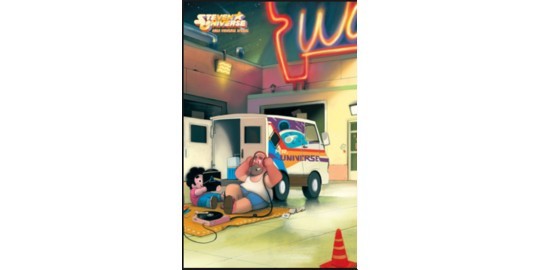
...But if you do see it, for the love of god buy it and let me pay you a bunch of money for it. Anyway, it’s a variant of the above and it contains the same stories.
One-Shot Comic: 2016 Special
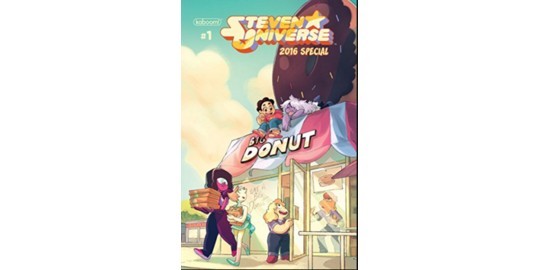
1 issue total
Published in 2016
Generally retailed at $7.99 USD
One-Shot
Another surprise! Steven Universe: 2016 Special, also known as the Big Donut Special, is also labeled #1 even though there was never a #2. It features a bunch of stories that center around the Big Donut and its employees Sadie and Lars. The above main cover is by Ayme Sotuyo. You may also see these variants by Missy Peña and Katie Jones:

These two are variants of the above and they contain the same stories.
One-Shot Comic: Fusion Frenzy
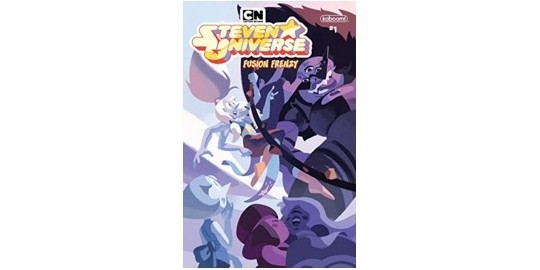
1 issue total
Published in 2019
Generally retailed at $7.99 USD
One-Shot
Steven Universe: Fusion Frenzy is another comic labeled #1 even though there (I heard?) will not be a #2. It features five stories, each by a different artist/author combo, about a different Fusion (Stevonnie, Garnet, Smoky Quartz, Opal, Sugilite). The above main cover is by Nathalie Fourdraine. It actually connects with one of its variants (also by Nathalie Fourdraine) to make a full picture, and there are two more covers (by Abigail L. Dela Cruz and Alexandra Lillie).

These, like the other one-shots, are variants of the above and they contain the same stories. Fusion Frenzy is self-contained and the stories in it DO NOT APPEAR in any Trade Paperback. You have to find the single issue to read it--it’s a standalone. It may be released in the future as part of a larger compilation, but that has not happened yet and as far as I know has not been announced.
One-Shot Comic Trade Paperback Compilation: Welcome to Beach City
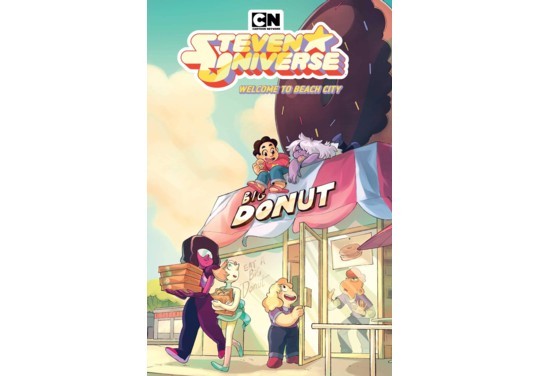
Includes the content of Greg Universe Special and 2016 Special
Published in 2019
Generally retailed at $14.99 USD
Contains two #1′s
For a long time the content for the Greg Universe Special and 2016 Special were not available if you couldn’t find individual paper issues, but that’s changed with Welcome to Beach City! It contains those two and their alternate cover galleries. The Fusion Frenzy from 2019 has not yet been released in a compilation, but these two have.
All-in-One Hardcover Edition

Includes the Original Comics from 2014 - 2015, the bonus comics that were included in the two graphic novel compilations, the 4 issues of Steven Universe and the Crystal Gems, the first twelve issues of the 2017 Series, and an abbreviated miniature cover gallery.
Published in 2019
Generally retailed at $45.00 USD
Does NOT contain one-shots, graphic novel content, or Harmony
This is a bit of a misnomer as it does not contain everything and stops at #12 of the 2017 series. (Obviously since it was an ongoing series at the time, you can’t publish a book of it until the series stops being ongoing, but if people want this because they think it’s everything, they should know it is not everything.)
Original Graphic Novels

Individual Novels
First one published in 2016
Generally retailed at $14.99 USD
Each is a One-Shot
As if this wasn't confusing enough with all these comic issues and variant covers and trade paperback versions of them, there are also original graphic novels! These are trade paperbacks that are complete in the large graphic novel form and were not previously individually released. They're legit graphic novels, and though the released volumes are not connected to each other story-wise, they are being labeled Original Graphic Novel 1, 2, 3, and so on.
The Original Graphic Novel #1 is called Too Cool for School. You may see it listed that way, or you may see it with no number. (For your information, Original Graphic Novel #2 is Anti-Gravity; OGN #3 is The Ultimate Dough-Down; OGN #4 is Camp Pining Play; and OGN #5 is Crystal Clean.)
Too Cool for School is about Steven trying to go to school with Connie for the first time. It has a second short story at the end about Vidalia having a yard sale. Its cover art is by Rosemary Valero-O’Connell and there are no variants.
Things that are not comics

You may run into the soundtrack, the show itself, minisodes of the show, or the coloring book. (If you want the coloring book, though, it's awesome. Just make sure you get the licensed one. People sell a lot of compilations that are edited screenshots and fanart, and they pretend they're official coloring books. They are not.)
Keep in mind also there are books--they tend not to have numbers on them, but if you see books such as The Answer, Guide to the Crystal Gems, Quest for Gem Magic, Steven Universe Mad Libs, What in the Universe?, Live from Beach City!, Best Buds Together Fun, Postcard Power!, Keep Beach City Weird!, Make Art! (On Purpose), Steven Universe: Art and Origins, Lion: Mane of Mystery, Fusion for Beginners and Experts, or the Steven Universe Sketchbook--these are standalone storybooks, insight books, or activity books for the series.
If you are a person attempting to purchase print media as a gift and just want a quick and dirty suggestion for what to buy:
Buy the graphic novels and the trade paperback compilations. Only die-hards will need every scrap of material, so it’s okay if you can’t find the Greg Universe Special or Big Donut Special. My recommendations:
Buying ONE ITEM for a comics fan? Get Warp Tour.
Buying TWO ITEMS for a comics fan? Get Warp Tour and Punching Up.
Buying a GROUP OF ITEMS for a comics fan? Just get them all the trade paperbacks, starting with Volume 1 (”Believe in Steven”).
Buying ONE ITEM for a fan of the show, and don’t know if they’re into comics? Consider Steven Universe and the Crystal Gems trade paperback, Anti-Gravity, or The Ultimate Dough-Down--they’re more like books--or you can actually get a regular book. Keep Beach City Weird is funny for any age and Steven Universe: Art and Origins is cool for deep diggers and older fans.
Buying INDIVIDUAL ISSUES? Absolutely recommend all of the one-shots--the Greg Universe Special, 2016 Special, and Fusion Frenzy. Try to scoop up the first few of the 2017 series OR, if the person’s experienced with comics, try the original series or Harmony.
Buying stuff for a completist? Start with old copies of #1 on eBay or KaBoom’s site. Open your wallet and cry.
Feel free to read my reviews of every piece of media in the franchise if that will help you.
316 notes
·
View notes
Text
Name ten favourite characters from ten different things (books, tv, film, etc.) then tag ten people
This was extremely difficult to do. The first two were easy, since they are my ride or die, but choosing 10 different characters? From ten different things? I don’t know if I even like 10 different things, but I found some loopholes, lol.
tagged by @bpdanakins <3
1. Lara Croft - Tomb Raider
Lara Croft has been one of my idols since I was a small child. My mom had bought Tomb Raider: Starring Lara Croft and Tomb Raider: Adventures of Lara Croft for my sister on the PlayStation. I remember watching my sister play it, and then sometimes I was allowed to play it. I continued the Tomb Raider legacy throughout the years.
Lara Croft is just. Amazing. I love every version of her. Classic Lara deflected the life her parents had wanted her to have, and paid the price for it. Did that stop her? No, it did not! She was able to make her own mark in the world. LAU!Lara wanted to find out what happened to her mother, and honestly I love Keeley Hawes as Lara. She was witty and funny, and Legend is one of my favorite TR games. And Reboot!Lara? I love her. I honestly don’t care what people say, Reboot!Lara is great! Her first game is also fun to play. Each version of Lara Croft offers something different, and I love it. While many of Lara’s core values are in each incarnation (adventurous, ambitious, brave, etc.), each brings a new perspective which I enjoy!
Fun fact: my irl best friend and Lara share the same zodiac sign!
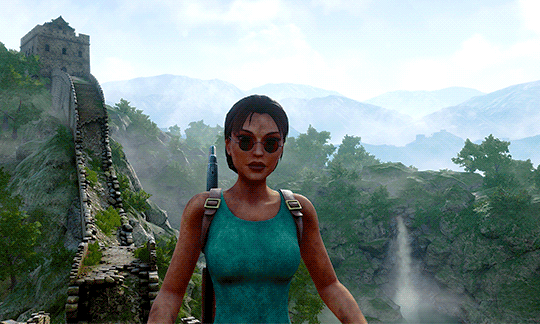
2. Wanda Maximoff (Scarlet Witch) - Marvel
I LOVE WANDA MAXIMOFF WITH ALL MY HEART!!! She’s a huge comfort character for me. She’s one of the most powerful mutants (yes, I am ignoring the retcon), and she’s complex. Wanda first appeared in X-Men #4 alongside her brother, Pietro, as members of Magneto’s Brotherhood. Eventually, the twins become heroes and join the Avengers.
Wanda’s mutation is magic; probability, to put it at best. She can warp reality. While she is strong, she is also human. Many remember her best as having a mental breakdown and creates House of M (influenced by her beloved brother). After this, she goes off the radar for a few years before her reincarnated sons find her.
I love Wanda because she has heart, courage, and cares for others. She’s intuitive and sensitive and, in many ways, reminds me of myself. I genuinely love Wanda with all my heart. She remains to be my number one favorite superhero. I wish more people knew her--the real her. The MCU does not do her (or her brother) justice. At all. (At least AOU kind of got their “reluctant villains to heroes” origin story well enough?)
Also: fuck you Marvel for retconning Magneto as the Maximoffs’ father. It’s been 5 years but I still elect to ignore that.
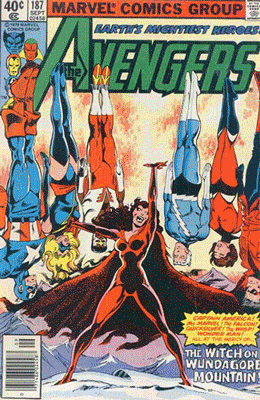
3. Phoebe Halliwell - Charmed
Growing up, Charmed was one of my favorite TV shows. To sum it up, it’s about a group of sisters who discover that they’re witches. Specifically, they’re the Charmed Ones and they protect the innocent. For awhile, I’ve said that Piper is my favorite sister but after my last rewatch, I say that Phoebe is my favorite.
At the beginning of the series, Phoebe was the youngest and the rebel of the family. Before the pilot, Phoebe was living in New York but we see her move back in. We also see that she has a strained relationship with her eldest sister, Prue, due to her scummy fiancé. Phoebe is also the reason why their magic was unlocked. (As children, their powers were bounded in order to keep them safe.)
Over time, we see Phoebe mature more. However, there are a few things that never changes with Phoebe. She’s kind and caring for others, always wanting to help them no matter what. (She shares this trait with the youngest sister, Paige.) She is deeply connected with her emotions (which causes her to gain the power of empathy in season 6). Phoebe has also had rough luck with love (see: Cole the demon, etc.) but no matter how much she gets hurt, Phoebe still has hope. She still has love in her heart. No matter how much she gets knocked down, she finds a way of getting back up, and I admire her a lot for it.

4. Catelyn Stark - A Song of Ice and Fire
Family. Duty. Honor. This is House Tully’s family motto, which is deeply embedded into Catelyn. Catelyn was married to Ned Stark during Robert’s Rebellion, after her former betrothed was murdered in King’s Landing (who, ironically, was Ned’s older brother). Their wedding night resulted in the birth of their firstborn: Robb Stark, heir to Winterfell and King in the North.
Catelyn Stark is the mother of the wolves, and her love for her family is no doubt a core of her character. However, Catelyn is clever and if you mess with her, you will certainly gain her wrath. Her eldest values her for her wisdom, and will turn to her for help. She will do anything for her family, such as freeing Jaime Lannister to get her girls back, or offering herself to save her eldest during the horrific events of the Red Wedding.
Catelyn is murdered, along with majority of the Stark party, at the Red Wedding. However, she is resurrected and becomes Lady Stoneheart. Stoneheart is out for vengeance, because she believes all of her children are gone; taken by the enemy. Stoneheart murders Frey or Lannister alike--whoever is associated with them. She holds no mercy.
There is so much more to Catelyn that I could go on, but I will stop here. (Besides, I need to reread the books again!) I will say this: fuck you, D&D.
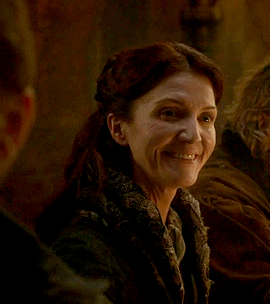
5. Erik Lehnsherr (Magneto) - Marvel
MAGNETO TIME? MAGNETO TIME.
Erik Lehnsherr was a young boy when World War II happened and because he was Jewish, he was sent to Auschwitz. His family did not survive, but Erik did. Depending on what you follow on, Erik either A) escaped with Magda (who is the Scarlet Witch and Quicksilver’s mother) and started a life with her or B) he hunted down the men who worked for Sebastian Shaw (movie universe).
Anyway, Erik had been a mutant since around the time he was sent to the camps and after the horror and trauma he’s faced, Erik decided that mutants would never be accepted by “their less evolved kin”. So, he became Magneto, a protector for mutants and enemy for humans.
Magneto is only one side of the coin, however. Charles Xavier is a longtime frenemy of sorts, both having different perspectives in life. Xavier believes in coexistence, but Magneto believes otherwise. He had seen what humanity is capable of, and he never wants that to happen again. If he must be a villain, than so be it.
Magneto is beautifully complex. He has done some questionable things (I’m thinking of the comics for this one), but he has also done great things for his people. “Never again,” he says. He fights to keep it that way. Magneto is sympathetic at best, and I certainly understand where he comes from. Tell me this: if you were Magneto, what would you have done?
Also: while Michael Fassbender is not Jewish in any way, he did one hell of a job portraying this amazing character.

6. Kira Yukimura - Teen Wolf
I wasn’t planning on adding Teen Wolf to the list, but here I am.
Kira was introduced to us in season 3b, written as a “new love interest” for Scott McCall. I remember a lot of fans of a certain ship were pissed, but whatever. I’m not here to talk about romance.
So, in 3b Kira was a new student, with her dad as the new history teacher at Beacon Hills High School. She’s of both Korean and Japanese descent, and she ends up playing an important role in the story arc. We find out that she’s a Kitsune, thanks to her mother who explains how a Kitsune and a werewolf must come together to defeat the Nogitsune, who happens to be possessing the loveable Stiles Stilinski.
After this, Kira becomes a part of the McCall Pack and Scott’s girlfriend. In my opinion, they’re cute together but many people hate them together. Oh well. Kira also becomes a badass in her own right, as her abilities evolve. However, in season 5, the creators put her on the shelf, as she trains with Skinwalkers and is never seen again. I am so fucking MAD about that.
Like many characters on this list, Kira has heart and courage. She’s a bit of an introvert but she is loyal, and cares for her pack. She’s cute and a bit goofy. She is skilled and deadly. Kira is one of the coolest characters Teen Wolf had, and the way they treated her was disappointed. (Even though after her death, Allison was always mentioned/connected in some way. I like Allison, don’t get me wrong but all I can say is: interesting...)
Fun fact: Arden Cho, the actress, is the VA for Sam Nishimura in Tomb Raider (2013)!
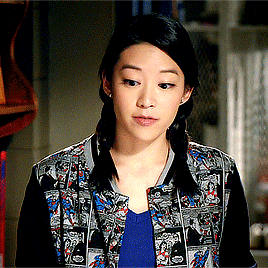
7. Lois Wilkerson - Malcolm in the Middle
The mother of four boys, the matriarch of the Wilkerson household is not one to push around.
Lois has had a rather rough life. Her parents were not the best, and everyone tries to push her down. However, Lois fights back and is not afraid to stand up for what is right. Francis, her oldest, describes her as an absolute menace and while her sons and husband fear her, they also admire her for her strength and courage. Lois is tough as nails, but she can also break, too. However, her family--the family she and Hal created, no one else--is there for her. Lois is incredibly strong willed no matter what, and I love her so much.
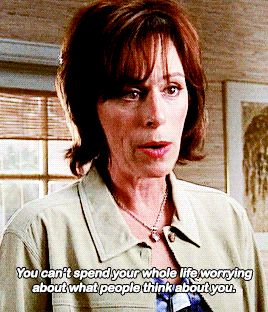
8. Theon Greyjoy - A Song of Ice and Fire
No words can describe on how much I love this fashionable war criminal.
Before the start of the series, Theon is a hostage/ward of Lord Stark, as a result of his father’s failed rebellion. Theon was a reminder that if Balon Greyjoy pulled something again, his last (male) heir would get the chopping block. Pretty brutal for a young child, right?
Now, at the start of the series, Theon is nineteen and is seemingly best friends with Robb Stark, the heir to Winterfell and the North. He shows loyalty to Robb and the Starks, claiming that Lord Stark was like a father to him. He’s also skilled with archery and, like I mentioned earlier, fashion.
Then A Clash of Kings occur, and we began to see how Theon Greyjoy is.
Robb Stark has been proclaimed as King of the North, and sends Theon to the Iron Islands in hopes to gain allies with Balon Greyjoy. However, this does not occur. Old Greyjoy says “fuck that and if you’re [Theon] aren’t with us, then you‘re against us.” We see Theon conflicted, but we also see how strained his relationship with his father is. In the end, Theon joins the Greyjoys, and promptly sacks Winterfell. However, that is not the end. Theon is tricked by Ramsay Bolton and this vile man takes Winterfell. I believe while he took the women and children captive, the men were killed...save for Theon, of course.
Theon is held captive by Ramsay Bolton, and is tortured quite brutally. Theon goes through a lot in this time. His appearance had changed drastically: black hair turned white and brittle, he becomes skin and bones, and loses a few fingers and toes. Theon is no longer Theon. He became Reek. The new Reek.
Then, Jeyne Poole (or Sansa; I hate you D&D) arrives, under the guise that she is Arya Stark and she is to wed Ramsay Bolton. Jeyne begged Theon to help her, but he is in no position of power. He is a completely broken man. Time flies by. Jeyne is in absolute misery but with the help of Mance and some spearwives, Theon is able to escape Winterfell with Jeyne during a winter storm. Currently, in the books, Theon is set to be executed by Stannis Baratheon, who is currently holding him captive.
Theon Greyjoy may be a fuckup, but to me he is such an amazing character. He holds much conflict, from being a hostage/ward to Prince to prisoner. Theon Greyjoy may have done a lot of shit, but he is also a survivor. Everything he has been put through, he somehow lives to see another day. Despite holding negative feelings to Lord Stark and everyone around, claiming he owed no one anything (fair enough), he loved Robb. When Theon had found out he was murdered at the Red Wedding, you know what he thought?
I should have been with him. Where was I? I should have died with him.
Theon is far from perfect, but that is what makes him great. He has come so far, and I hope his journey does not end any time soon.

9. Suki - Avatar: The Last Airbender
Zuko may have the best redemption arc (or does he? See above.), but Suki holds a special place in my heart.
We first meet Suki season one, on Kyoshi Island. She is the leader of the Kyoshi Warriors, and effectively puts Sokka in his place. However, when Sokka requests a few lessons, Suki is happy to help...as long as he followed the guidelines.
Suki is a certified badass. Although a non-bender, Suki has incredible skill and event went against Azula. However, Suki and the others surrendered (so that Appa would not be captured), leading to her imprisonment at Boiling Rock. Eventually, Sokka and Zuko free her (with the help of Mai). After this, Suki joined the Gaang in ceasing the 100 Year War.
Suki is strong but like many other characters in this list, she has heart. She is an effective leader and fighter, offering her help whenever she can. Too bad she was never mentioned in The Legend of Korra. Suki is underrated and she deserves more love and respect.

10. Max Mayfield - Stranger Things
We first meet Max in season 2 as the new girl in Hawkins. She seems like your average girl but she quickly gets tied into the party after Lucas begs her to show her what has happened with him and the rest of the party. However, there’s a lot more to Max.
Max moved to Hawkins with her mother, stepfather, and stepbrother. It’s easy to see that Max and Billy, her stepbrother, do not get along. Billy is outright mean to her, lashing out at practically every chance he gets. Max fights back, however...especially when he threatens her friends.
In season 3, we finally get to see Max and El bond. (Thank God we didn’t have to put up with the “jealousy” tidbit. I would have--) El believes that Mike is lying and Max is like, “Well yeah. Come on let’s go to the mall!” and the girls have a blast together. I was so happy to see the two bond and have fun. I was so happy that El was spending time with someone other than Mike. I was so happy the girls were having fun by themselves. Honestly, the best part of season 3 was them becoming friends.
I love Max because she is confident and is not afraid to speak her mind. She’s funny and in many ways, we are alike. (Especially with our attitudes on boys and relationships.) However, Max is also vulnerable. We see this with her stepbrother, especially in season 3 I think. Their relationship was drastically different in season 3 and while many didn’t like it (myself included)...I also thought about Max. She’s a young girl and no matter how much bad blood was in between them, it will be traumatizing to see a transformation like this to someone you know quite well. It would be scary.
Anyway, I love Max.

Honorable mentions: Kitty Pryde (Shadowcat), Ororo Munroe (Storm), Jean Grey (Phoenix), Anna Marie (Rogue), Sam Nishimura, Malia Tate, all of House Martell, Dustin Henderson...
Thanks for reading! I hope you all enjoyed reading this. Tell me, do I have a certain type of character that I’m attracted to? Also, I’m not sure who has all done this, so if you haven’t it: who are your top 10 favorite characters? Let me know!
#mads makes a text post#about#bpdanakins#tomb raider#marvel#charmed#asoiaf#game of thrones#teen wolf#Malcolm in the middle#atla#stranger things#lara croft#wanda maximoff#phoebe halliwell#Catelyn stark#erik lehnsherr#kira yukimura#lois wilkerson#theon greyjoy#suki#max mayfield
36 notes
·
View notes
Photo
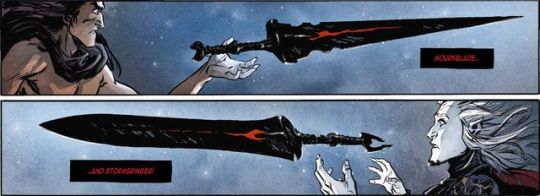


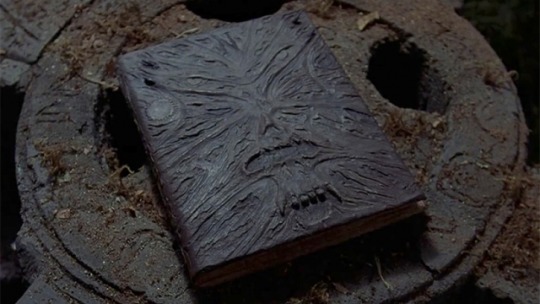
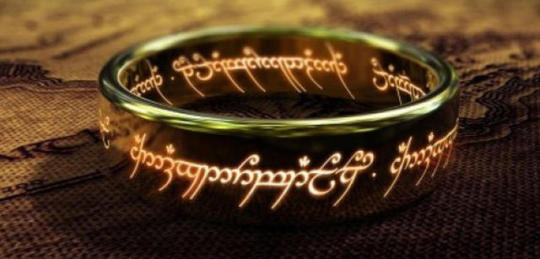

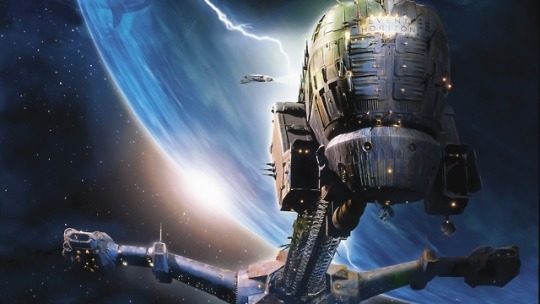

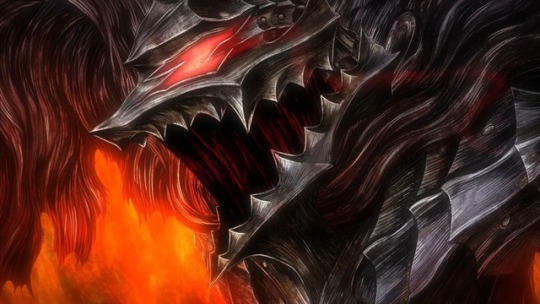
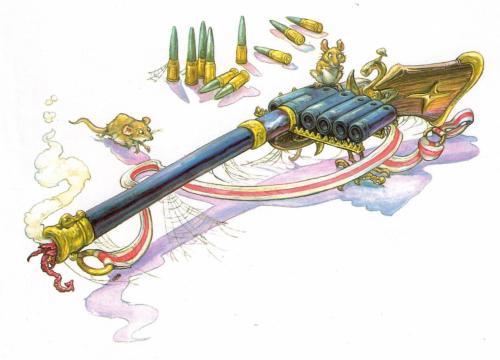
30 Day Monster Challenge 2 - Day #16: Favorite Evil Weapon/Object
1. Stormbringer (Elric of Melnibone)
The Black Blade. Daughter of Arioch. The Stealer of Souls. One of the single most legendary swords in all of fantasy, present in every universe in at least one form or another. A demon of chaos bound by the Lords of Law into the shape of a weapon. Whoever wields it can drain the souls from whoever they stab and sustain themselves with it, but is driven by a terrible hunger. The Black Blade has a will of its own, and it howls for blood as it is swung. In short, the definitive evil weapon.
What makes Stormbringer stand out from its later imitators, and even previous legendary evil weapons, is how it affects its primary wield, Elric of Melnibone. As an albino, Elric is sickly, and usually uses medicine and dark magic to stay alive. But abroad in the Young Kingdoms, Elric has to rely on Stormbringer to survive. Even as Elric connects with people outside his home kingdom, they are bound to die whenever he needs to stay alive, no matter how much Elric tries to fight it. Stormbringer is essentially a manifestation of Elric’s burden as the Champion of Balance, but also his greater isolation that distances him from being able to make connections. Elric makes it clear that Stormbringer isn’t some kind of ultimate weapon, it’s a crutch, a drug that ultimately consumes its user. And in the end, that’s what happens to Elric; when the entire universe is consumed by chaos, Stormbringer finally turns on Elric before disappearing into the apocalypse.
2. Soul Edge/Soul Calibur (Soulcalibur)
So this is honestly cheating, but I just can’t pick between the two swords. Soul Edge is the clear Stormbringer descendent and looks rad as hell to boot. Even more that Stormbringer, Soul Edge looks like a living, breathing monster. It can even shapeshift into weapons that aren’t sword, and it had an entire life cycle in Soulcalibur 2. But Soul Edge never really stopped being the ‘bad’ sword. It’s counterpart, Soul Calibur, on the other hand, started off as the ‘good’ sword. But as the series went on, Soul Calibur began to change. In Soulcalibur 4 it was hinted that Soul Calibur might have a mind of its own as well, and it might not have the purest intentions. By Soulcalibur 5, the plot hook came to fruition; Soul Calibur is just as dangerous as Soul Edge and wants to trap the world in a perfect unchanging state. The swords have become the embodiments of Law and Chaos; the Michael Moorcock reference comes full circle. All we need now is a game where Soul Calibur is out of control and the only thing that can stop it is Soul Edge.
3. The Terror Mask (Splatterhouse)
The Terror Mask has sass, the Terror Mask has a personality. Half these evil artifacts are just kind of generically malevolent; they won’t yell at you in Jim Cummings’ voice and call you a pussy when you notice one of your arms is missing. There’s a surprising amount of lore invested in the Terror Mask. An entity from the space between spaces, it fled the cosmic horror gods until they bound it in a bone mask. Now it’s out to settle the score, and whoever is wearing it just happens to be along for the ride. Granted, the wearer of the mask turns into a hulking slasher ogre that is almost impossible to kill. The Splatterhouse games are a gateway into the video game id, replete with monsters, ultra-violence, and a hero so buff he puts the ‘masculine’ in ‘toxic masculinity’. The Terror Mask, like in the game, is just a way to get to that special kind of hell.
4. The Necronomicon Ex Mortis (Evil Dead)
The Necronomicon Ex Mortis is probably the most famous evil book in the world, probably more so than Lovecraft’s original Necronomicon. (Frankly, I could do an entire list on favorite evil books, but we’ll get there when we get there.) The Ex Mortis really doesn’t have a lot to do with Lovecraft besides the name, other than that they are both old, sanity-rending, and bodies of literature. But, being honest, the Ex Mortis is just the more fun of the two. The Ex Mortis is the party-boy of evil books to the original Necronomicon’s Ivy League scholar. It’s such an embodiment of Sam Raimi horror; gory, campy, with a bit of slapstick thrown in, and its mere presence causes weirdness to happen. The Necronomicon Ex Mortis contains knowledge of things man was not meant to know, and it knows it. It’s mischievous, and it’d almost be lovable if it wasn’t also full of immensely powerful black magic.
5. The One Ring (Lord of the Rings)
I’ve always been interested by the concept that the One Ring can think for itself. The One Ring is, ultimately, an incredibly loyal evil artifact, and is only interested in new yielders insofar as they can deliver it back to Sauron. The Ring really is an apt counterpart for the hobbits; a little thing, defenseless, almost useless at first glance, but capable of changing the world. The Ring also has a pedigree, of course. It shares more than few traits with the Ring of Nibelung from the Wagnerian cycle of operas of the same name. The Nibelung Ring, like the One Ring, can grant the wearer power over the world, but only if they renounce love. In time, the covetousness of men and gods for the ring destroys the world and brings about Ragnarok. The One Ring is a reflection of the Ring of Nibelung, but also vastly different in many respects. It brings about the end of the gods and immortals, but only because they were staying to try and destroy it. The end of the Ring and of Sauron grants the world the ability to move into the next age, the age of mankind, which reflects not only Tolkien’s notions about divinity and its place in human existence, but I think also his faith that people can rise to their best in the changing times.
6. Rubilax (Wakfu)
Rubilax is the only evil weapon here to have a character arc. Granted, that’s because he’s actually a demon bound to a sword, but whatever. Rubilax starts out as your typical evil sword, trying to possess the (idiot) paladin bound to guard him. Not to make it a contest, but he gets pretty far, to the point that said paladin has to release Rubilax and fight him in a bare-knuckle fist fight into submission. After that, things get kind of complicated. People die, souls are displaced, there’s a colosseum death match, and Rubilax has to make some calls about his moral character, so to speak. In the end, Rubilax decides to side with the good guys, and even gets along with the paladin’s kids. So he’s less of an evil weapon and more of just a demonic one, but he’s definitely the most nuanced character here.
7. The Event Horizon (Event Horizon)
The Even Horizon is pushing the definition of ‘evil object’. It’s really more of an evil place, which might also be worth a look sometime, but for now a ship counts as an object. There’s plenty of sci-fi stories that try to do the cursed spaceship deal, but I feel like Event Horizon is the only one that really captures the gothic horror aspect. I think we tend to forget that architecture, aside from its practical usage, is also meant to convey ideas and thoughts as much as any other form of artistry, and was one of the more important forms of public communication before the spread of reading. The architecture of the Event Horizon is the words to a spell, the three-dimensional incantation that opens the gates of Hell. It was a morbid, dark temple to man’s ignorance even before it went into other dimensions. Once it returns, it hungers for more; a cursed ship bound to always return to its home port on the other side. Something about the Event Horizon reminds me of the Rime of the Ancient Mariner; the way the ship is warped and changed by sailing through strange waters, and how the survivors are bound to relive the curse over and over again. That’s why the Event Horizon is my favorite ghost ship in science fiction.
8. The Marker (Dead Space)
The Marker draws directly from Event Horizon, and they both share the concept of wordlessly communicating a kind of madness to the people who view them. The Marker, though, takes it to a new extreme, in that it has a literal insanity aura that causes hallucinations, paranoia, and aggressiveness. An interesting way that the Marker is more ‘alive’ than other evil objects is that it is self-propagating; part of the madness it transmits is the formula necessary for its replications. But what I find most fascinating is how the Marker can transmit information that changes DNA, altering people on the cellular level to turn them into Necromorphs. That kind of power, to change biology through information, is nothing short of magic in most other settings.
9. The Berserker Armor (Berserk)
You can’t fight demons if you ain’t cute. The Berserker Armor was forged by dwarves for the explicit purpose of fighting demons and monsters. It draws on the rage and negative energy inside a person to give them incredible strength and agility, but at the price of slowly draining their senses. The Skull Knight originally made it for himself, but even he was scared off by the armor’s power. Now Guts has it, and he has a lot of rage to give. I think the most fascinating thing about the armor is how it changes and molds itself to how Guts’ uses it. It didn’t start off with a giant wolf helmet; that’s just Guts’ personal totem representing his inner darkness. But when the armor drew on that, it changed shape, and when Guts holds himself back, it stays restrained. Still, the armor takes a lower spot because it itself isn’t evil, it just draws on a person’s internal negativity; it’s all up to the wearer on how much they use it.
10. The Gonne (Discworld)
Discworld is full of anachronistic magical devices, and they’re all usually cause for some kind of concern. The Gonne was at the center of a fairly elaborate murder plot involving the Assassin’s Guild and the Night Watch, but was finally put a stop to. Like any good evil weapon, it whispers promises of power to whoever happens to be holding it at the time, and is also a little trigger-happy. But the Gonne and its metaphor for firearms gets kind of overshadowed by everything happening around it, and it even gets acknowledged as a powerful and worthy weapon in its own way by the end.
#30 Day Monster Challenge 2#30 Day Monster Challenge#soul calibur#lord of the rings#dead space#wakfu#evil dead#berserk#long post
134 notes
·
View notes
Text
Jimin’s journey in the Bangtan Universe #11: Isolation and the slightly unsettling serenity
#0: Intro
#1: The one who laughed the loudest
#2: In this place of eternal mayhem the party never stops
#3: Youth is not coming back
#4: An impression of being stuck
#5: “I’m trapped inside myself and I am dead”
#6: The forbidden fruit
#7: Darkness crept in
#8: A deal with the Devil
#9: A picture, a painting, rain, fire and tears
#10: A redemption and/or salvation arc
So here we are back again. It’s the long-awaited continuation to the BU narrative arc. Let's get to it.
On a general level it seems we have gone back to approximately the Prologue SF era so in terms of a linear timeline, we are back to the very beginning of the story. Of course “linearity” of time might just be an illusion. With Seokjin's narration pondering about turning back time and righting mistakes in the end of the Highlight Reels and now the release of Euphoria, it seems the BTS creative team has put those ponderings into play.
I have seen a lot of discussion about SJ's role in the time warp, if he is actively controlling it and how. I don't really have anything to contribute to that. I'm more of a multiverse type of person, i.e. the theory that there are an infinite amount of parallel universes being created at every moment and with every choice. The differences between the universes might be big (Taehyung killing his father or not) or small (the boys wearing white instead of black) but each difference launches a whole new universe with an infinite more differences to be made. Unintended consequences might be a phenomenon to be explored.
But as always, I'll be focusing on Jimin's journey. And as always, our point of entrance to his story is in the I Need U MV bathtub, although this time the waters are calmer. The video seems to be "glitching" a bit.
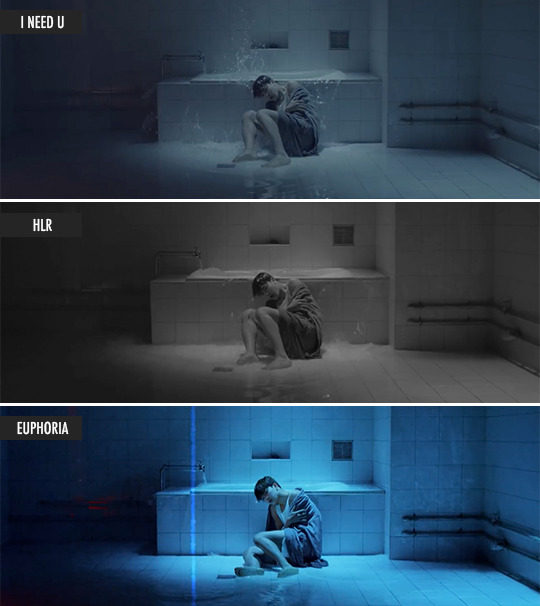
In many ways the Euphoria SF brought things that have only been implied before to the forefront. For instance, it's the first time we see his hospitalisation in the "real-life". It was implied in the Lie SF but in a very conceptual, stylised way. I have previously explained in analysis #2 why I don’t think JM was actually in Hoseok’s hospital room in the Run MV.
We also seem to get confirmation that JM and HS did spend time together in the hospital as there is one scene where both of them are wearing hospital clothes. It's a peculiar tableau of a scene, frozen in a moment as the camera slowly rotates around to reveal a fearful-looking JM holding HS’s hand.
At a first glance you might get the impression that HS is stepping away from JM. He maybe looks a bit disappointed. The mood is somber.
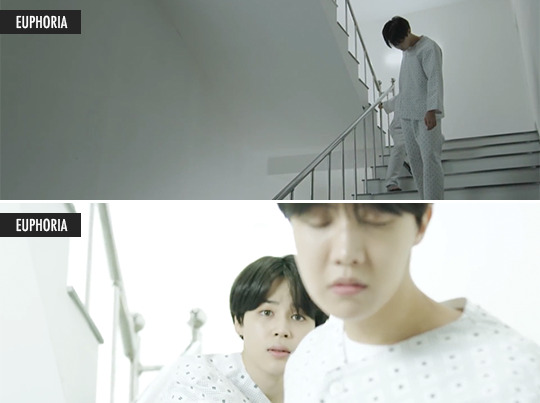
But at a closer look it’s not that simple. There is a quick hidden edit at the middle of the sequence where we see another angle of the scene overlaid with the original shot.
In it HS looks to be teetering over his own feet with his head hanging low, seemingly in danger of falling down the stairs. JM is holding him back and trying to keep them both in balance by clutching the handrail. Is HS passing out like he prone to do based on the INU MV? We don’t see a resolution for the scene.
The effects used as well as the colours or lack thereof remind me of the hyper-sterilised world of the Lie MV.

Another thing that has remained largely unaddressed thus far but is now made quite central is the overarching theme of JM's loneliness and isolation throughout the BU grand narrative. I talked about it especially in the context of the HYYH series but also in Spring Day.

In Euphoria this is made evident most acutely in the shots of JM alone in the hospital. The image of him skipping around the empty game room, obviously waiting for the other members to come visit him makes it quite painfully clear.

When the members do visit for JM's birthday, we see a lighthearted scramble to get to the hospital exit in a slow-mo pandemonium reminiscent of the Spring Day MV birthday scene. The way the mad dash begins with Namjoon at the game room door and ends with JM triumphantly throwing away his hospital gown (and pulling his SD shirt on instead) makes me think they are running away from the hospital staff and busting JM free, even if it's just for a day.

I have seen quite a few fans suggest that the members' visit never took place and was maybe all in JM's head. I guess in the BU anything is possible but I don't see any particular reason to think that. If nothing else, we do have the photographic evidence of the guys being there, in that room, wearing the clothes we see in the video. Of course the photographs might be hallucinations as well, but to me the interpretation is starting to get unnecessarily convoluted. For now I have no reason to think they were never there.
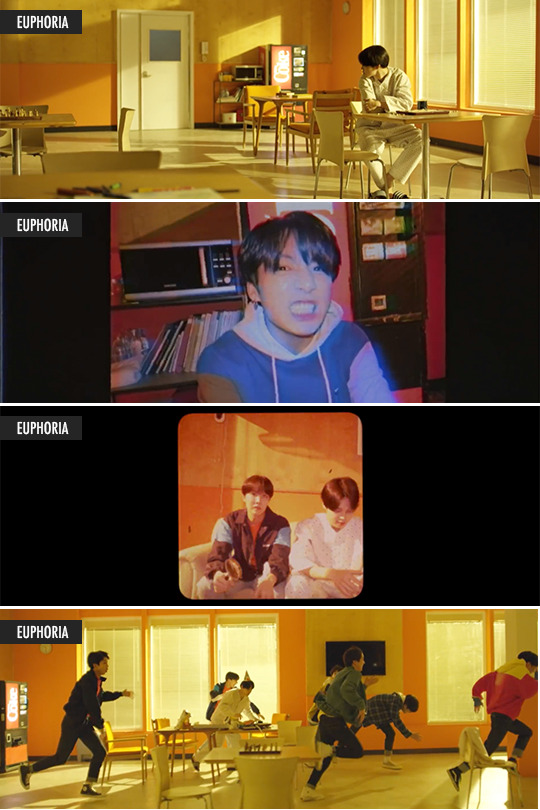
That is not to say he's not lonely. In a recreation of the "escape" from the hospital as described above, JM is seen running down the same hospital corridor towards the exit, but this time he's alone. And this time he stops himself before getting to the door.

I'm sure I'm not the only one who is reminded of the Serendipity MV with these hospital scenes. The way JM is dressed in loose, white clothing while his environment is in warm yellow hues. The isolation and the slightly unsettling serenity of it all.
In my previous analysis I called Serendipity a bittersweet respite in JM's otherwise bleak narrative, so if we want to establish a connection between JM in the Serendipity MV and JM here in the "real-life", then right now the most compelling explanation for me is that it's the world of Serendipity that is in JM's head. It's his happy place full of wondrous things he goes to when the loneliness gets to be too much.
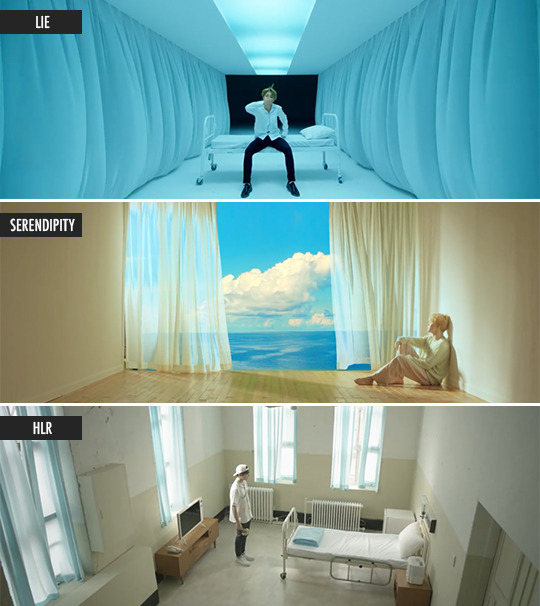
We still don’t know for sure if and how Serendipity connects to the events in the BU but having seen this and knowing that Euphoria precedes Serendipity, I don't think I'll ever be able to see it quite the same way again.

After the escape from the hospital we transition to a montage of the guys hanging out and messing around. The way the running scene in the hospital corridor is edited to this makes it seem like it's the aftermath of their escape but in fact none of the guys are wearing the same clothes, so we should consider it a separate occasion.
And this is where it gets a bit strange.
Next up >>
#12: Time warp
#jimin#bts#bts theory#euphoria#jihope#hoseok#film analysis#fan theory#lie#serendipity#spring day#bangtan universe#jimin's journey
128 notes
·
View notes
Text
Film Re-Review - Star Trek: First Contact
Carrying on the re-reviews of the TNG films, it’s time to look in on the film many consider to be the best of the films focused on Picard’s crew, namely First Contact.
Plot (as given by Wikipedia):
Captain Jean-Luc Picard awakens from a nightmare in which he relived his assimilation by the cybernetic Borg six years earlier (shown in the television episode "The Best of Both Worlds"). Starfleet informs him of a new Borg attack against Earth, but orders the USS Enterprise-E to patrol the Romulan Neutral Zone so as to not introduce an "unstable element" to the fight. Learning that the fleet is losing the battle, the Enterprise crew disobeys orders and heads for Earth, where a single, damaged Borg Cube opposes a group of Starfleet vessels. The Enterprise arrives in time to save the crew of the USS Defiant which is being commanded by Lieutenant Commander Worf. After Picard hears Borg communications in his mind, he orders the fleet to concentrate its firepower on a seemingly non-vital section of the Borg ship. The Cube is destroyed after launching a smaller sphere ship towards the planet.
The Borg sphere generates and enters a temporal vortex. As the Enterprise is enveloped in the vortex, the crew briefly glimpses an Earth populated entirely by Borg. Picard realizes that the Borg have used time travel to change history, and orders the Enterprise to follow. The Enterprise arrives in the past, on April 4, 2063, the day before humanity's first encounter with alien life after Zefram Cochrane's historic warp drive flight. The Borg sphere fires on the planet; realizing that the Borg are trying to prevent first contact, the Enterprise crew destroy the sphere and send an away team to the Montana missile complex where Cochrane is building his ship, the Phoenix, to look for survivors. Picard sends Cochrane's assistant Lily to the Enterprise for medical attention, then returns to the ship and leaves Commander William Riker on Earth to make sure the Phoenix's flight proceeds as planned. The Enterprise crew sees Cochrane as a legend, but the real man is reluctant to assume his historical role.
Borg survivors invade the Enterprise, and begin to assimilate its crew and modify the ship, planning to use it to attack and conquer Earth. Picard and a team attempt to reach engineering to disable the Borg with corrosive coolant used in the warp core, but the android Data is captured and meets the queen of the Borg Collective, who gains his trust by giving part of him human skin. A frightened Lily seizes the captain but he gains her trust, and they escape the Borg-infested area of the ship by using the holodeck. Picard, Worf, and the ship's navigator, Lieutenant Hawk, stop the Borg from calling reinforcements with the deflector dish, but Hawk is assimilated. As the Borg continue to assimilate, Worf suggests destroying the ship, but Picard angrily calls him a coward and vows to continue the fight. Lily confronts the captain and, reminding him of Moby Dick's Captain Ahab, makes him realize he's acting irrationally. Picard activates the ship's self-destruct mechanism, orders the crew to abandon ship, and then apologizes to Worf. While the crew heads to escape pods, Picard remains aboard to rescue Data.
As Cochrane, Riker, and chief engineer Geordi La Forge prepare to activate the warp drive on the Phoenix, Picard confronts the Borg Queen and discovers she has grafted human skin onto Data, giving him an array of new sensations. She has presented this modification as a gift to the android, hoping to obtain his encryption codes to the Enterprise computer. Although Picard offers himself in Data's place, the android refuses to leave. He deactivates the self-destruct sequence and fires torpedoes at the Phoenix, but they miss and the Queen realizes Data betrayed her. Data ruptures a coolant tank, and the corrosive substance fatally dissolves the Borg's biological components. Cochrane completes his warp flight, and that night, April 5, 2063, the crew watches as Vulcans, attracted by the Phoenix warp test, land and greet Cochrane. Having repaired history, the Enterprise crew returns to the 24th century.
Review:
Back when I originally reviewed this film, I didn’t quite agree with the consensus of many that this film was somehow the high point of the cinematic run for Picard’s crew, but coming back to it several years later on the heels of watching and reviewing the whole preceding TV series, I’m re-considering my previous position. It’s certainly an improvement over the previous film Generations, in large part due to the writers not being constrained by a wish list of plot elements from the studio, as well as long-time Trek actor and director Jonathan Frakes being allowed to make his cinematic directorial debut. The films helmed by Frakes (who of course plays Riker in TNG) tend to be the best TNG films to me, which supports the idea that Trek films are best tackled by people who know Trek from having already worked with it.
Now annoyingly within the wider TNG timeline, First Contact is the third feature-length time-travel story; we had Picard time-hopping in the feature length series finale ‘All Good Things...’, then Picard and Kirk meeting via the Nexus and doing time travel that way in Generations, and now we have First Contact. However, the reason for the time travel this time has more than enough resonance to compensate for this kind of repetition, because this time we’re going back to the birth of Trek itself. TNG’s best villains the Borg go back in time, and they pick the moment in the franchise’s history where Zefram Cochrane makes his initial warp flight and triggers the eponymous first contact with the Vulcans.
Original series fans probably had some issues with how the film portrays Cochrane, due to the character having once appeared in that series, but as someone whose interest in Trek began with the Next Generation series, I don’t have that issue. In addition, I also tend to rail against how much Roddenberry hamstrung the earlier incarnations of Trek with his infamous rules of Trek, known by writers as the ‘Roddenberry box’. All too often, Roddenberry set the idealism of Trek too high, and at times probably didn’t think all of his concepts through (the no money one comes up in one scene), so I find it refreshing that this film took that character and made him flawed, suggesting the veneration of Cochrane within Trek is a kind of historical exaggeration of the man.
Of course, it’s largely thanks to actor James Cromwell that Cochrane comes across as a great character, and to be honest all of the cast perform their roles well across the three plot-threads of the movie. The first thread is an away team on Earth led by Riker helping Cochrane. Second is that as Borg begin to over-run the Enterprise, Picard begins to fall prey to his past trauma at their hands and has to be talked down from putting vengeance above the greater good, and third is Data’s arc with the Borg Queen. The last of these is interesting in that it brings Data a bit closer to his goal of becoming human by offering him the chance to take on flesh and experience physical sensation. It’s a great expansion on Data’s ‘Pinocchio’ arc within the series.
Picard’s arc used to be a bit non-sensical to me in terms of its timing, as Picard ran into the Borg a couple more times between his assimilation in the series and this film, but what I’ve realised after watching the show again is that actually it does make sense. Not because of the whole trap of the ‘Roddenberry box’, but because the circumstances of each story in the overall Borg narrative doesn’t really allow Picard’s trauma to really come back at him. After the follow-up episode to ‘Best of Both Worlds’ where Picard finally unburdens himself of the initial impact his assimilation had on him, he only faced any of the Borg twice, and in both cases, he dealt with one or more individualised Borg. First Contact is the first story since ‘Best of Both Worlds’ where the Borg collective itself is involved, and rather than being on some distant planet or being on their ships, they’ve decided to hit at Picard on his home ground.
In addition, the Borg just deal set-back after set-back to Picard and the Enterprise crew as the film goes on, which fuels his speech to Lily (played by Alfre Woodard) when he refuses to destroy the Enterprise;
“I will not sacrifice the Enterprise. We've made too many compromises already. Too many retreats. They invade our space and we fall back. They assimilate entire worlds and we fall back. Not again! The line must be drawn here... THIS far, NO further! And I will make them PAY for what they've done.”
I think this line speaks to everyone who at some time or another has been forced to compromise something in their lives to someone or something else. For Picard it’s having to give ground to a race of cyborgs who violated him, but this could just as readily apply to people seeking equality in the present day, who perhaps to compromise just to make progress or avoid being penalised for seeking equality. It could apply to people in relationships that are one-sided at best and abusive at worst, always having to give ground to be ok in the short-term. It’s not something that’s necessarily been with Picard all the time, but something that builds, and it takes the objective viewpoint of someone not of his era to call him on it and bring him back to the Starfleet officer he’s supposed to be.
This leaves the away team story to provide comic relief (the Deanna drunk scene is a great example), and when you look at the plot and the performance together with a fantastic score and the new-style Enterprise, it really is a great film. For the benefit of fans of wider Trek, the film even takes care to provide an explanation for the return of Worf, who after the previous films had become part of the main cast on Deep Space Nine, and we get cameos by Robert Picardo and Ethan Phillips of Voyager in the film as well.
Now discounting the fact this is the third time-travel story in a run as well as past quibbles I used to have with the film and don’t now, there’s not much I can say against First Contact. I’m a bit concerned that so many men claimed to be slightly aroused by the Borg Queen if the film commentaries I’ve watched are to be believed, but that’s more about the film’s viewers than the films and to each their own, I suppose. It’s also probably the most accessible film to an audience not versed in the Next Generation, though it requires some patience to reach the areas of exposition in the film that compensate for anyone not having that series knowledge to start with. So, this time round, I’m going to up the film’s score. Where Generations went down from 8 to 7 out of 10 on re-review, First Contact had risen like the Phoenix from 8 to 10 out of 10.
0 notes
Text
Allen’s Rambles About Persona 4 Arena
So... back in my RWBY Rambling I said that I really wasn’t going to like May since I’d be doing my breakdown and retrospective on the Blazblue series for the release of Blazblue Cross Tag Battle. Well it turns out I suck at keeping a schedule when it comes to these Ramblings, because I still need to talk about Persona 4 Arena and Under Night In-Birth. Sorry for the wait folks, I just haven’t had anything to say about these two series until now. It was hard to figure out a good way to articulate how I feel about these two games. After a bit of thinking I now know how I want to tackle these series, so I’ll get started with Persona 4 Arena first then move onto Under Night at a later date.
With all that said, hello Persona 4 and Blazblue fanbase, I’m Allen X. I write fanfics, fan lyrics to video game songs I like, and occasionally write out an opinion piece or two when I’m in the mood.
I’ve been a big fan of the Persona series for a few years now, with Persona 4 Arena being the main thing that drew me into the series. Since then I’ve played Persona 3 FES, Persona 4, and Persona 5, even dipping in SMT: Devil Survivor 2 just for the sake of trying what the SMT universe had to offer, and reading through the manga adaptation of SMT: Devil Survivor 1. For those of you not familiar with the Persona 4 game and are curious about it... well, I’m sadly not going to explain the plot or story, but I do recommend watching the anime, Persona 4 the Animation if you want a crash course in what that game is about and not spend 60+ hours on a JRPG.
In any case, let’s get that Synopsis out of the way. I’m gonna’ be a little cheap this time around and copy the wiki page if that’s alright with you all. If I were to give a true synopsis of Persona 4 Arena I’d be spoiling Persona 4 and Persona 3. So then:
The game takes place two months after the events of Shin Megami Tensei: Persona 4 as well as two years after the Persona 3 FES's "The Answer" storyline. Like Persona 4, Persona 4 Arena takes place in the fictional, rural Japanese town of Inaba. However, most of the events occur in the TV world, a dimension that reflects people's feelings. In this game, the world takes the form of Inaba's Yasogami High School, which is divided in multiple areas that serve as arenas.
As Yu returns to visit Inaba for Golden Week, he and the others witness a commercial on the Midnight Channel for a fighting tournament, the "P-1 Grand Prix", hosted by what appears to be their friend Teddie. The tournament not only involves them, but also their companions Kanji Tatsumi and Naoto Shirogane. With their friends Rise Kujikawa, Kanji and Teddie missing, and Naoto absent, Yu, Yosuke, Chie and Yukiko decide to investigate. The following day, they enter the TV and find themselves stuck in a world resembling Yasogami High School.
So yeah, it’s literally a Persona 4 fighting game with some Persona 3 characters thrown in. I’d talk a little bit about Ultimax, but again I don’t want to fill this Rambling with spoilers
That done, I’ll move onto...
My History
Like I said, Persona 4 Arena was my first true dive into the series in terms of a financial purchase, but I’ve been familiar with Persona 4 since it first came out on the PS2 (God, I’m getting old). Yes, it looks like we’re two for two in terms of drama and fandom outcry not being what initially drew me to Persona 4 Arena and Persona 4 as a whole.
I actually got into Persona 4 when let’s plays of the original game was coming out. I mostly saw the clips and cutscenes of the game and was able to piece together enough about the plot to understand and enjoy it, but I was fully hooked when the anime came up, Persona 4 the Animation. I had a PS2 and PS3 at the time, but I really didn’t want to buy the game since the PS3 was starting to gain more prevalence and I was saving for other games. I found the anime it to be a great adaptation for the game, to the point where I can safely say if you don’t know about the story Persona 4 the anime is a great way to get caught up if you don’t want to spend 60+ hours playing the original game.
I bought Persona 4 Arena a little after it released in the West, and I found it to be one of the more accessible fighting games at the time, especially for anime air-dashers and for Arc System Works games in general. I had Blazblue at the time, but I sucked at it and just spammed revolver combos or Noel’s drive to get by, but Persona 4 Arena helped me get a better handle on how fighting games work.
Which brings me to...
The Appeal
I’ll be honest, this game doesn’t really have much appeal unless you’re a Persona fan. This game heavily references both Persona 4 and Persona 3 with how characters fight, a lot of flavor text that happened between characters, how a lot of the UI is displayed, and (most important of all) its story. I feel the same way about Dragonball FightererZ, this game is a love letter to Persona 4 and Persona 3 fans, but unless you like those two games there isn’t much to care about. I think outside of a love for the series the only other real appeal is the accessibility. Before DBFZ came out, Persona 4 Arena was probably the most accessible Arc System Works fighting game out there. There was an auto combo system for new player to use, but there were also some more complex systems to it too, liking properly using EX moves and EX supers, managing Awakening Mode, properly using strong and Persona attacks in your combos do a large amount of damage, and so on.
Though, it I were to give a personal appeal of the Persona 4 Arena, namely for Ultimax, it’d be Golden Arena Mode, an RPG-esque mode that lets you gain experience, level up your character, and gave you wicked-powerful buffs as you get stronger. It was a great call back to Blazblue arena, and something pray get’s put into Cross Tag Battle somehow.
So all in all, not much I can say to sell Persona 4 Arena to people that have never played a Persona game. In any case, I’ll be moving onto...
My Mains
What kind of Fighting Game Retrospective would this be if I didn’t talk about who I mainly play? Just a quick explanation before I go on. When I play a fighting game, I usually have two to three mains, and about 4 subs. The main reason being in case someone gets extremely nerfed and become unplayable in a competitive sense. Now I rarely play top tier characters for this reason, but... well, they nerfed Answer in Guilty Gear for some God-forsaken reason, so I think I was right to have Ram and Chipp on the side. The reason I have so many subs is because I play these games on a more casual level, and I like experiment with just about everyone... except the grappler characters... sorry Kanji.
But anyway, here are my Persona 4 Arena Mains

Yosuke is basically the ninja of the game, and as you will see in future Ramblings, I usually main toward the ninja, the only games I haven’t would be Under Night In-Birth where I sub Seth, Virtua Fighter were I just haven’t touched Kagemaru yet, and... that’s really it. Yosuke is “Mixups the Character”. He has a move for just about every situation and can easily confuse his opponents. A warping sweep, kunai throws, his moonsault, God’s gift to all Yosuke mains, Tentrafoo, and Sukaja. And honestly, this is probably the most fun I’ve heard Yuri Lowenthal have voicing the guy. He sounds so energetic.

Along with the ninja, I always main who I believe is “Best Girl” of that series. Now that’s a very subjective matter, I know, but I’ll just say that Chie is a rushdown-heavy character that I could get down with. I think this was my first time hearing Erin Fitzgerald’s voice too, and what a way to do it. I think she sounds great as Chie, at least for the fighting games. I’ll save my critique of Persona 4 for a later date, but her Power Charge ability and God Hand can one-shot just about any opponent. She’s a bit of a glass cannon as a result, but God what a cannon.

So... SHO Minazuki. I really like his playstyle, mostly because I don’t have to worry about his Persona breaking since he doesn’t have one. He’s rushdown-heavy like Chie, but he’s a little more risk-reward. His all-out attack has a weird hitbox, but other than getting around that I have a lot of fun playing him. I like him, I like him a lot.
I also subbed Yukari, Marie, Teddie, and Sho MINAZUKI, but these are my three mains.
So, with my main’s out of the way, I’m going go straight into...
The Conclusion
I sorry this Rambling isn’t like the monster the RWBY Rambling was, but I’m honestly very apathetic to Persona 4 Arena as a fighting game. As a Persona game I’ve got some issues with how it writes some of it’s characters and how contrived the story feels, but over I find it to be a solid game in general and worth getting if you’re a fan of Persona.
3 notes
·
View notes
Note
What are your top 3 favorite Kanker Sisters moments? Individually and/or together?
AAAHH you know I can’t narrow it down.. Buckle up because I’m 4 days behind on Kanker asks and have a busy day ahead of me!
1. Big Picture Show has to be my top favorite use of the Kanker sisters, for finally utilizing the Kankers’ devotion to the Eds and the Kankers’ distance from the kids to naturally create an advantage that I was suggesting should happen on message boards before we even got the post-Fistful arc. I was very excited to see that come true. It’s weird how the movie kinda trails off and doesn’t suggest a next step for the Kankers’ development from there, but it is honestly a different enough characterization that it makes sense that the movie would only need to show the aftermath. In a way, Fistful was more or less the series finale for the Kankers’ tired limited role. BPS pretty much perfectly pays off the fandom’s interest in the Kankers by giving them an unusually-positive antihero role without losing those cruel Kanker tactics that make them who they are— I’d even say their scenes help humanize the kids before their ending developments, by having the kids suffer at the hands of the Eds’ original antagonists. I wonder how much the Kankers knew at this point that the other kids attack the Eds, because it seems to me like they weren’t clear that it was meaner than name-calling until Jimmy tattled on the kids. And while most of the sisters’ story happens off screen, we see several pro’s and con’s behind their teamwork, and ultimately their success in rounding up the more threatening half of the kids reaffirms how strong the Kankers are as a unit, something the show previously couldn’t appreciate because it was just one of the Eds’ many disadvantages. The other thing that’s cool about recentering them as the kids’ enemies and becoming a much-needed protective element for the Eds (especially Lee attempting to save Eddy from Bro before even Edd or Ed do), is that it humanizes the Kankers and shows a more well-rounded inner life to their misbehavior without going overboard redeeming them to the point that it just pretends their misdeeds never existed. These are the Kankers I was always interested in and would love to see a spin-off about.
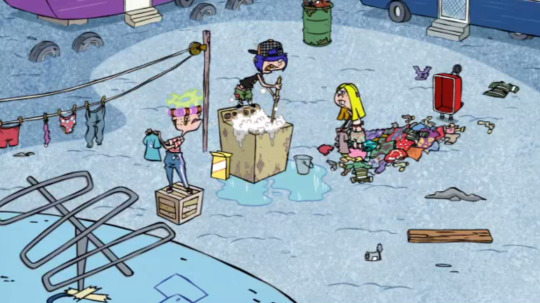
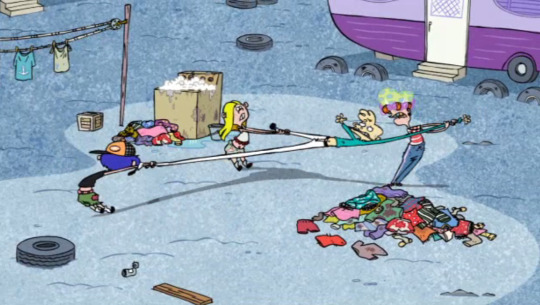





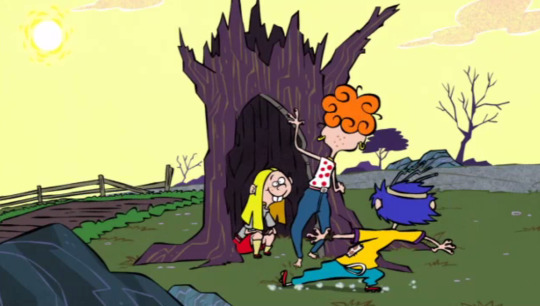

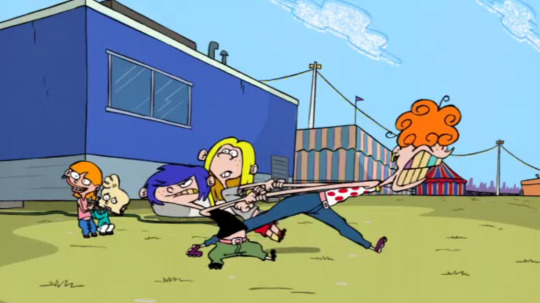
2. After that I’m not sure what to pick. Part of me wanted to say Jingle Jingle Jangle because I like how the Kankers spend most of that episode on a spiritual journey, and technically try to give the Eds gifts they probably don’t actually mind... but the ending is still one of my least favorites.

Season 4 was a pretty strong Kanker season, although they appeared as rarely as ever, ‘Ed Overboard’ seems to begin the trend of the Kankers getting to be main characters independent of the Eds’ perspective, as well as a thread Hanky Panky Hullabaloo continues in which May is shown to be more naïve and soft than her sisters would ever let on, and ‘Run For Your Ed’ is a really memorable and fun episode where they don’t even really affect the Eds.

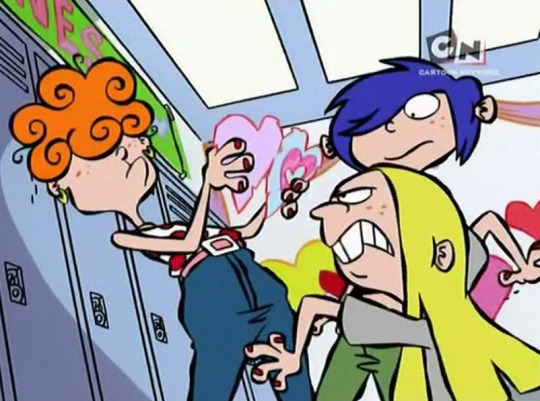
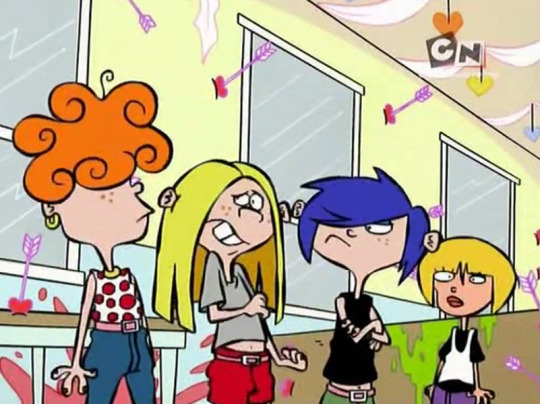

I think my favorite from this Kanker era has to be ‘A Twist of Ed’, though, I think from day one it felt like ‘Nagged to Ed’ was inevitably going to lead to a sequel where the Eds reverse the roles. But where ‘Nagged to Ed’ barely resembles the show’s later days, ‘A Twist of Ed’ is at a high point for the show’s style and it’s a delight to see the Kankers finally getting to be as expressive and active and relateable as the Eds. The ending backtracks from some of the depth the story starts to find in the Kankers, but damn if the drawings don’t give that episode all the momentum it needs to be a classic.
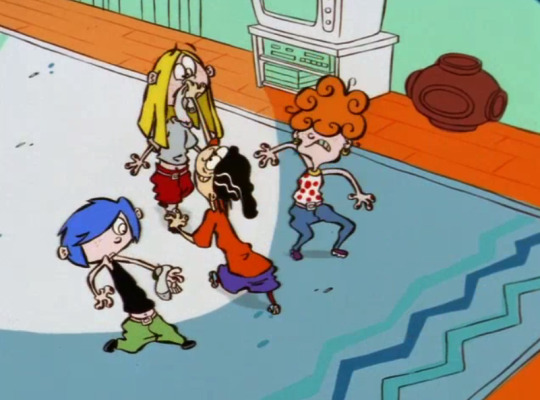

3. So, I guess this list is more like a ranking of eras by ending, middle and beginning, because my original plan was to end with ‘Nagged to Ed’ since it’s such a detailed distillation of the Kankers’ home life and probably the series-best use of the show’s parentless format to highlight the ways familial neglect and abuse warp these kids’ minds. But ‘Avast Ye Eds’ really ups the Kankers’ ante as a force to be reckoned with, a lot closer than ‘Nagged…’ to how they will be portrayed in the rest of the seasons, and season 2’s ‘Homecooked Eds’ is what I consider to be the defining early episode for the different flavor of humor the Kankers’ sisterly squabbling brings to the Eds’ world.

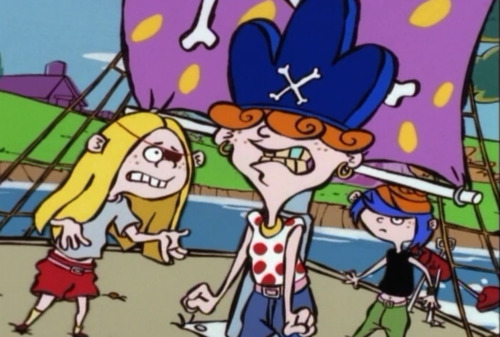

26 notes
·
View notes
Text
So today’s Rip Hunter Appreciation Week topic is favorite episode. And honestly, that’s hard to decide! I think I talked about Out of Time for the last Rip Hunter Appreciation Week. So this time, I’m going to pick Land of the Lost.
Land of the Lost is basically an episode that seemed like it was designed solely with "appeal to Kalinara" in mind.
One of the things that strikes me about Land of the Lost is how smoothly it wraps up Rip's season 2 story. I remember back when the season was supposed to have only 13 episodes, without an announced back orders, the creators had said that they planned to finish season 2's arc by episode 13, and use the back half for something new.
Obviously they didn't do that. Probably because four episodes isn't really long enough to establish a completely new plotline. So the Spear and Legion arc got stretched out a bit. But I think they kept Rip's own arc on its original time table. I honestly think Rip's Moonshot storyline was an early jumpstart on what he'll have in season 3. (I've mentioned before that, assuming Darvill stays a regular, then his departure in Aruba makes complete sense as part of a storyline branching off of Moonshot.)
But I digress.
As Rip Hunter's season finale, Land of the Lost is a great episode. It doesn't particularly make sense, but if I watched Legends to make sense, I'd probably have a concussion by now. What it is, however, is awesome.
Outside of Rip's plot, we have dinosaurs (awesome), an explicit acknowledgement of Amaya's significance to the timeline (which I've wanted for ages), a look at Ray's time in the prehistoric, and Mick actually deciding to use his Chronos experience. All things that I am happy to check off my wishlist.
And in Rip's plot, we have:
1. Evil Rip being hot and competent, effortlessly taking over the ship. And then that truly lovely bit of "fuck you" defiance when he was pinned down, in a ship with an active self destruct, and decided to turn around and (awesomely) blow up the medallion instead of surrendering.
And how awesome was that shot? Off hand and without aiming!
2. Sara and Jax getting the main heroic plot to save damsel Rip from his own mind. They're a great team up that work really well together, and I particularly liked how the episode subtly underscored Rip's relationship with both characters.
3. A mindscape! I was a bit sad they couldn't or wouldn't get any of my wishlist characters back (Miranda, Jonas, baby Rip, Savage, Druce, et al), but I thought they did a pretty good job with the budgetary and other constraints. I thought the concept of the mindscape was coherent (the idea of Rip's conscious mind as the dominated ship, with the warped view of the team works very well with his overall arc.)
And there are so many interesting things to explore ABOUT the mindscape and what subconscious!remnant!Rip might have experienced during the who-knows-how-long period of time he was trapped in his own head.
My "possible future posts" list has so many bits from this episode on it. It's ridiculous. (Subconscious Rip vs. Conscious Evil Rip, Evil!Mick, Subconscious Rip's attitude toward the crew(s), and so on!)
4. GIDEON! This episode did an amazing job of fleshing out Gideon as a character, rather than just a cheery, sometimes sarcastic/sassy voice that banters with Rip. From the beginning, we got the whole brig conversation, in which Gideon appeared to be defying orders to speak to evil Rip at all. (But really, how could she ignore her long-time partner when he called for her?)
Mindscape Gideon was such an interesting kettle of fish. Not in the least because we finally got to see the woman behind Gideon's voice. But there is so much interesting analysis about Gideon as a mental projection/concept of Rip, and what exactly that means from his perspective, and then of course how Gideon-the-AI intersects with that concept.
And of course, Time Ship.
(As someone who grew up gobbling Anne McCaffrey's ship series, I find the romantic potential between a man and his AI partner/ship incredibly interesting. Oddly, I don't have a whole lot of interest in versions of the pairing where Gideon gets a human or physical body, though. For me, the appeal in the pairing is in all of the unconventional ways they can explore their feelings and regard for one another.)
5. We actually got to see Rip's bedroom! In season 1, I had generally started to worry that he didn't have one at all and maybe just slept in his office. Assuming he slept. And it was amusing to see that he's STILL a packrat.
6. Phil isn't dead! Or he is. :-( But Rip does remember being Phil, so at least a little bit of that poor helpless fellow is still alive.
7. Cognitive Intrusion is creepy and violating as fuck, and I am both thrilled and amused that the show finds a way to make the Time Masters worse and worse every time they're mentioned. I love that Rip disliked the procedure too.
My only tiny quibble is that I wish the crew had shown a tiny bit of doubt in using the machine on Rip. I'm not saying that they shouldn't have done it. It was absolutely necessary if they were going to save Henry. But still, I would have liked them to hesitate a moment when they learned how violating it actually is.
It does appeal to my gallows humor that two mind-rapes make a right though.
8. And of course there was the reunion at the end, which was everything I could hope for. Rip, all fragile looking but safe now. The cautious welcome back.
I still think "I liked you better when you were killing people" is objectively speaking the worst thing any of the protagonists on this show have said to each other. But Rip doesn't seem to mind.
There is just so much to unpack and dissect and well, it's probably a good thing we have a long hiatus between seasons because my blog audience is going to be SO SICK of all of the crazy follow up posts I'll be making about it.
30 notes
·
View notes